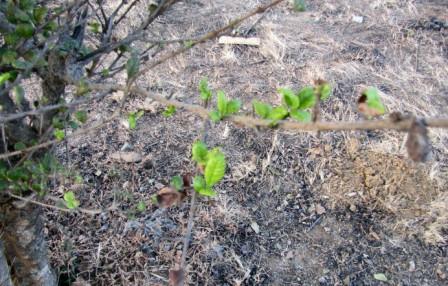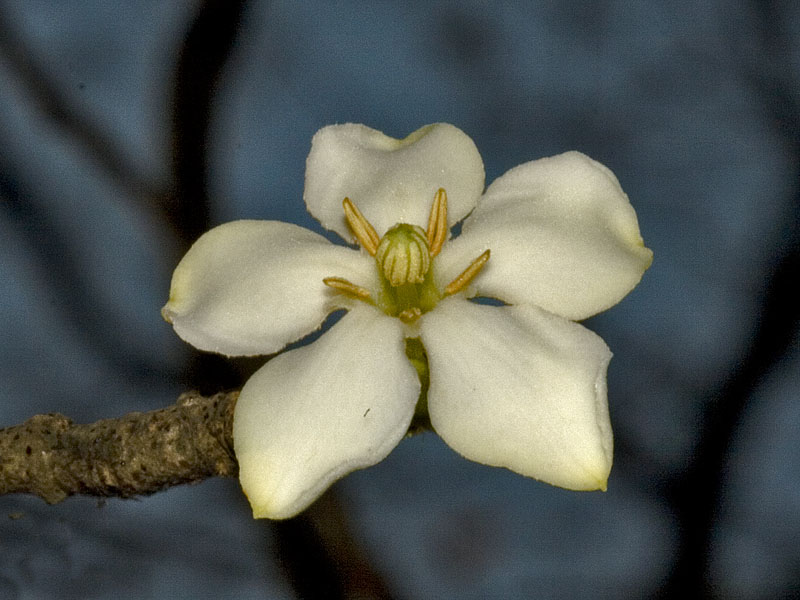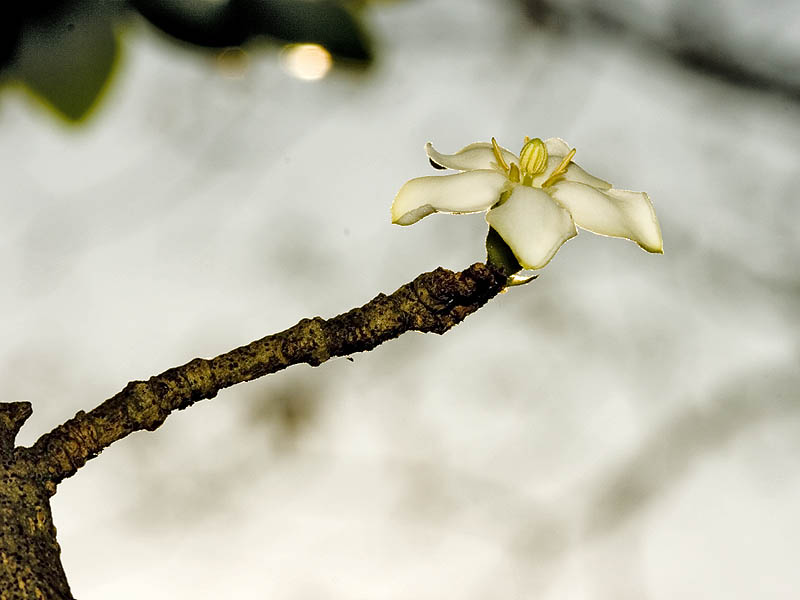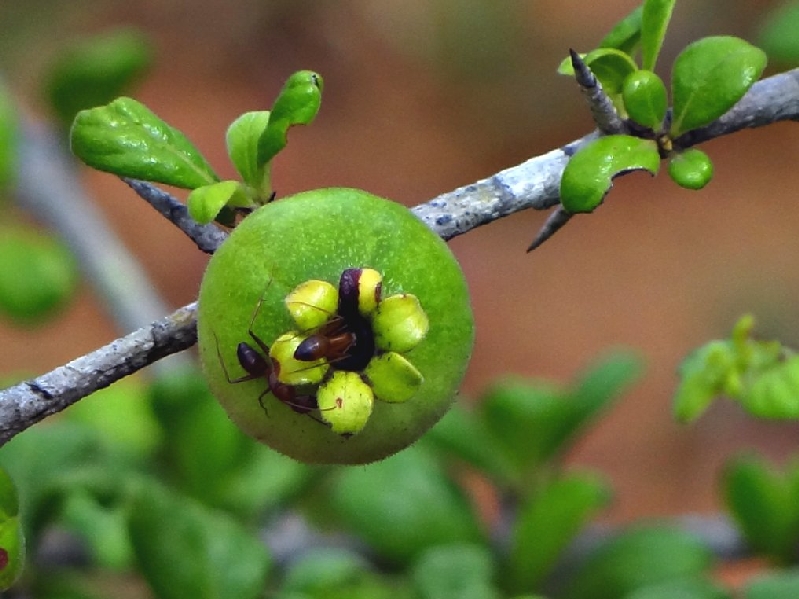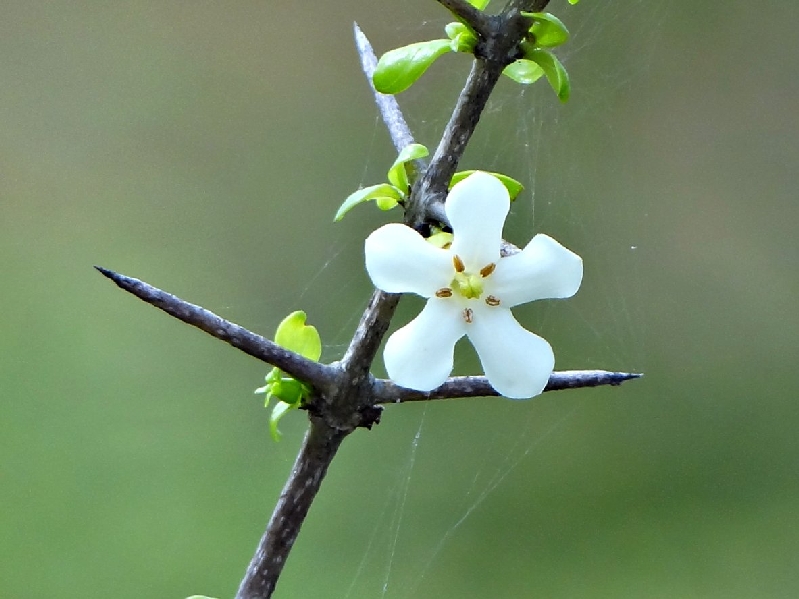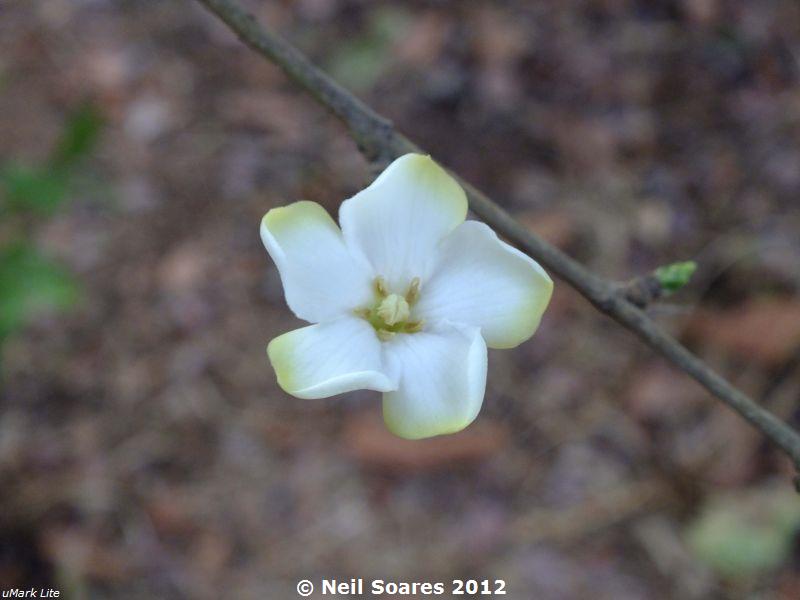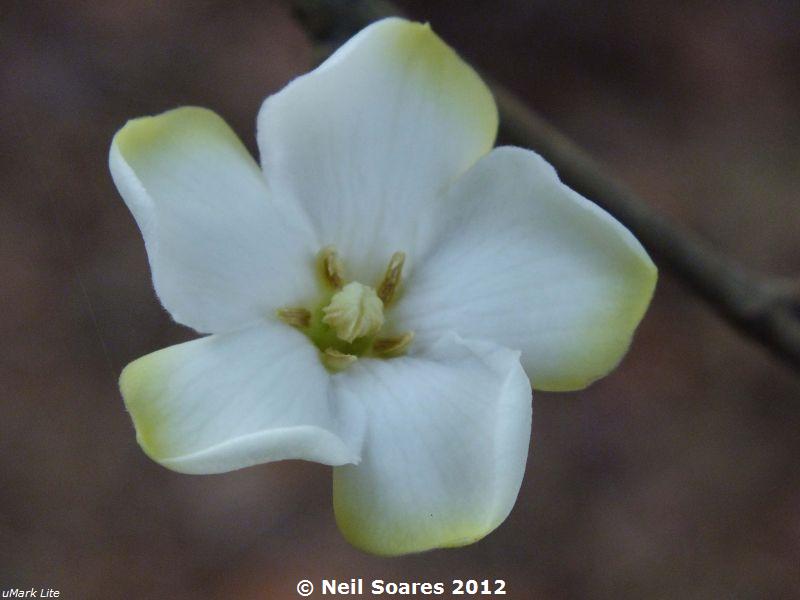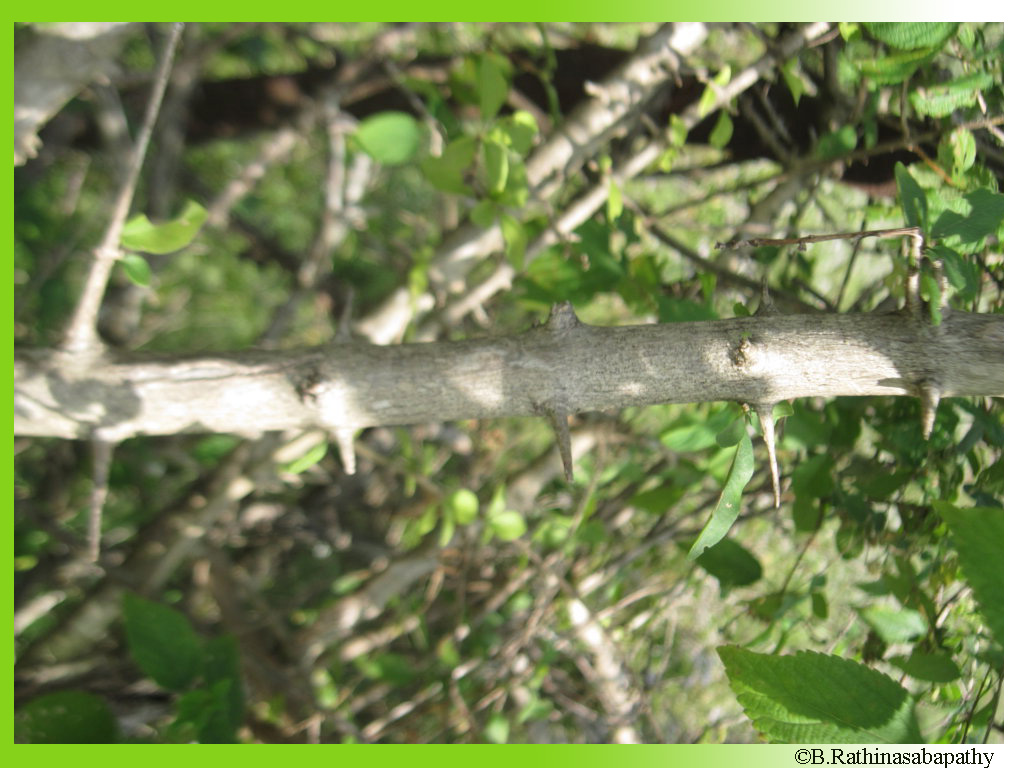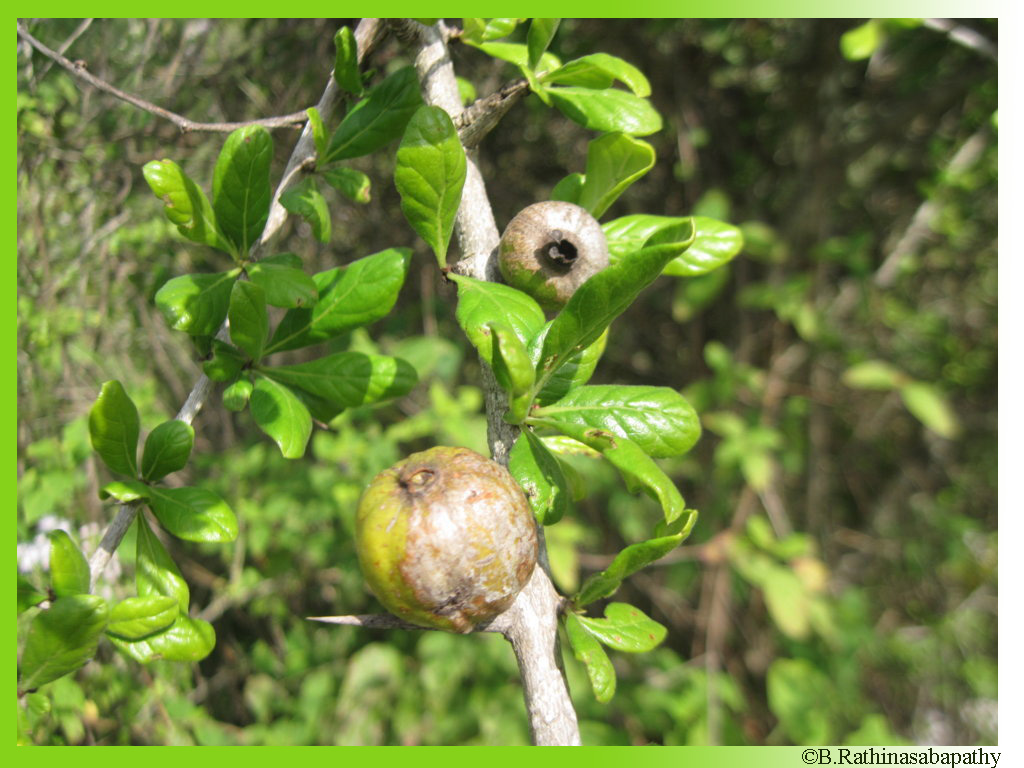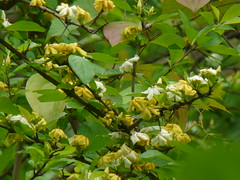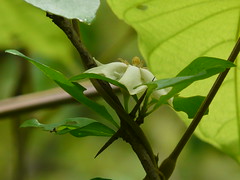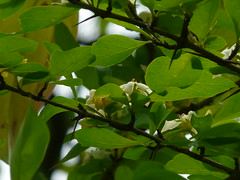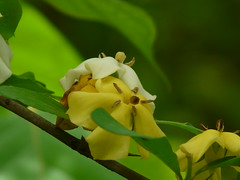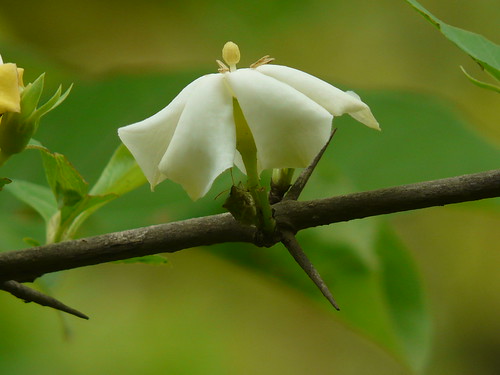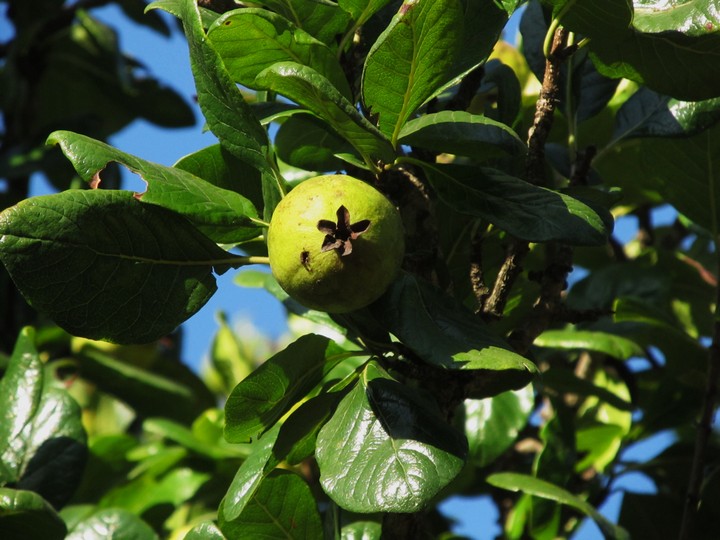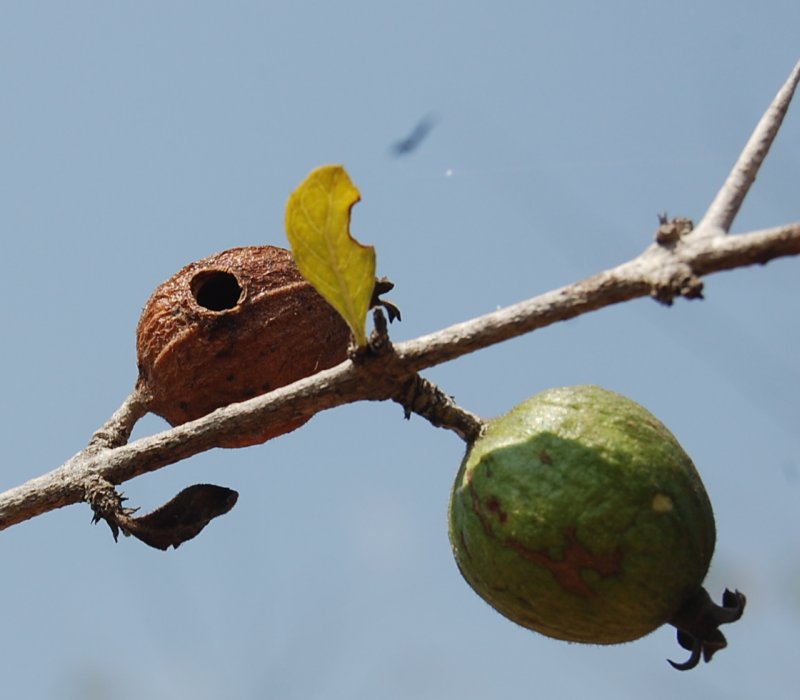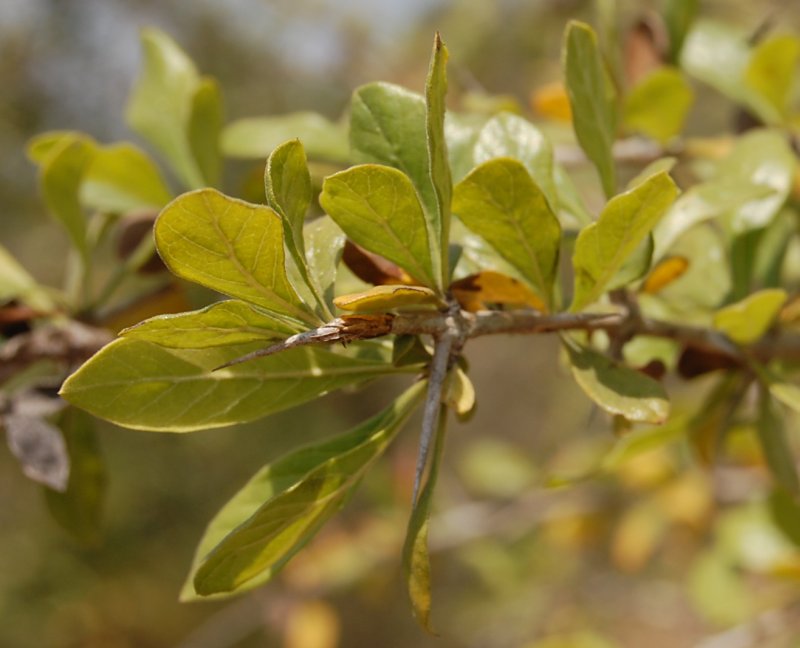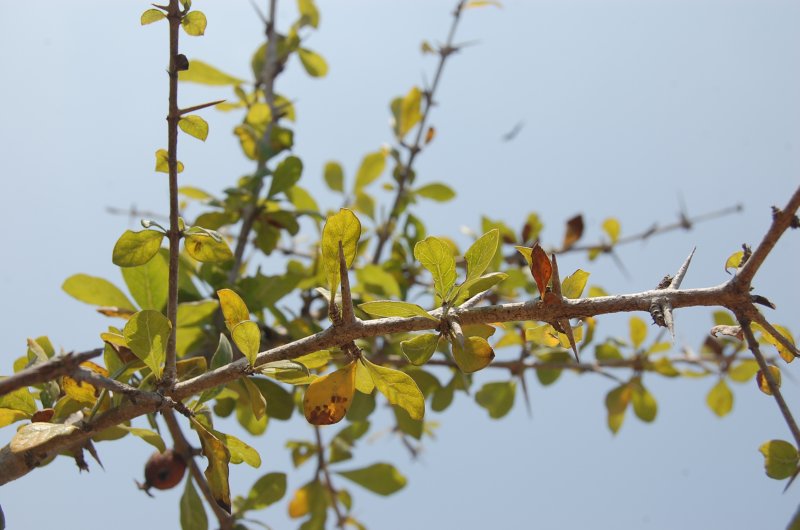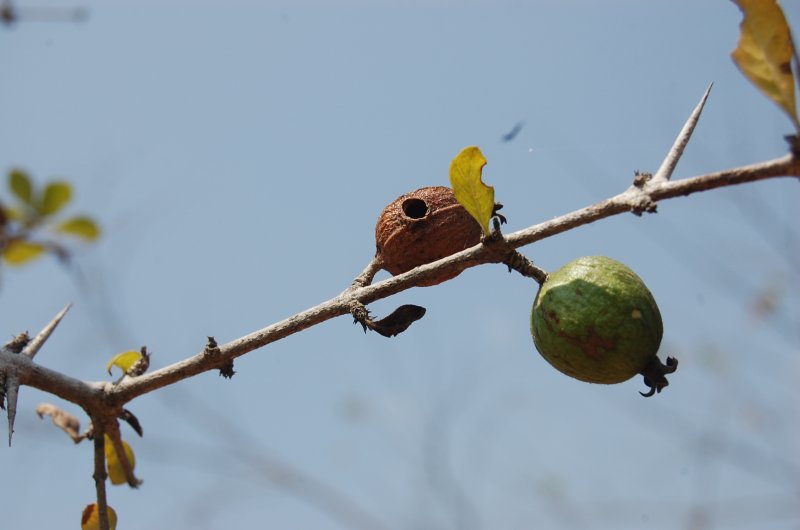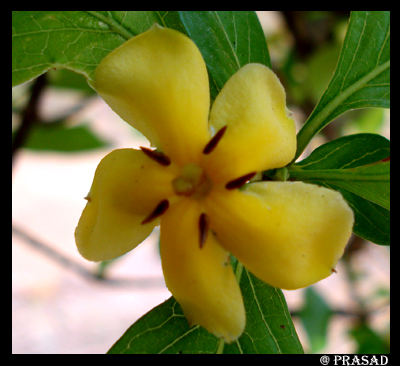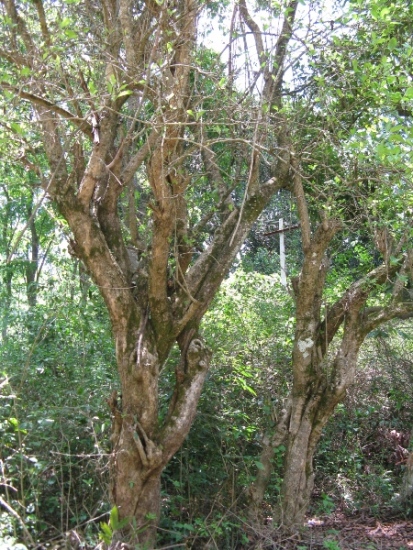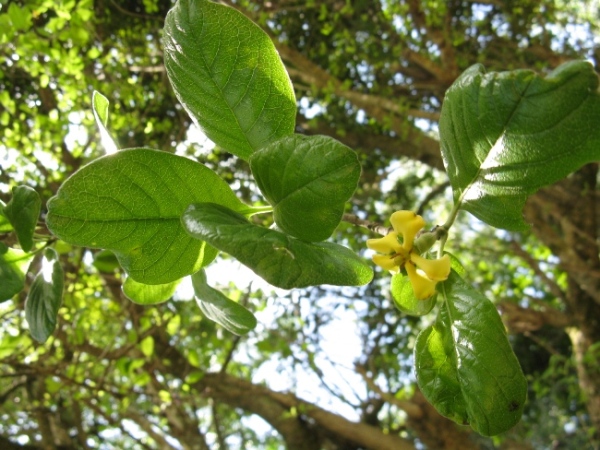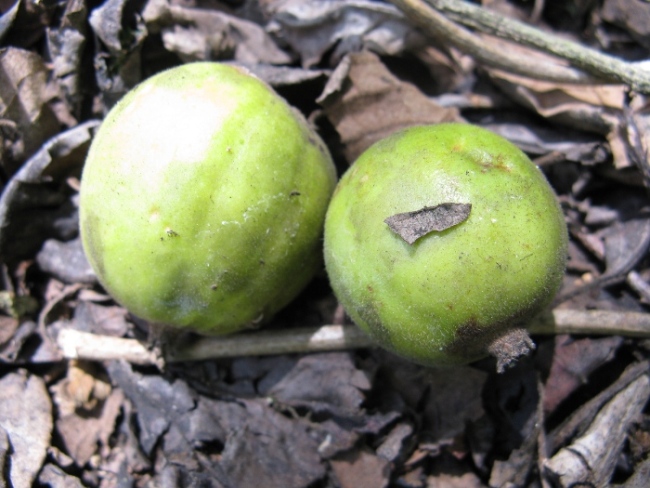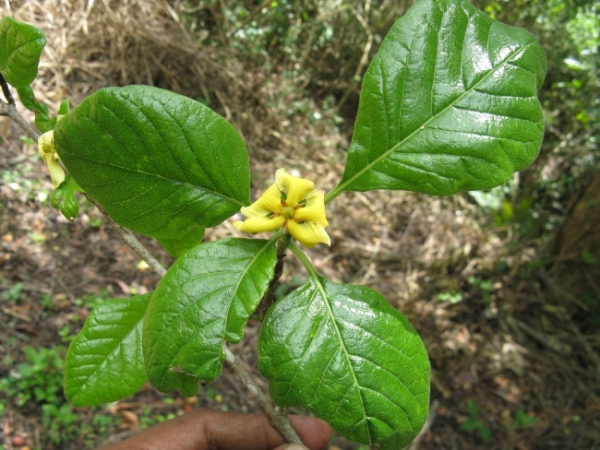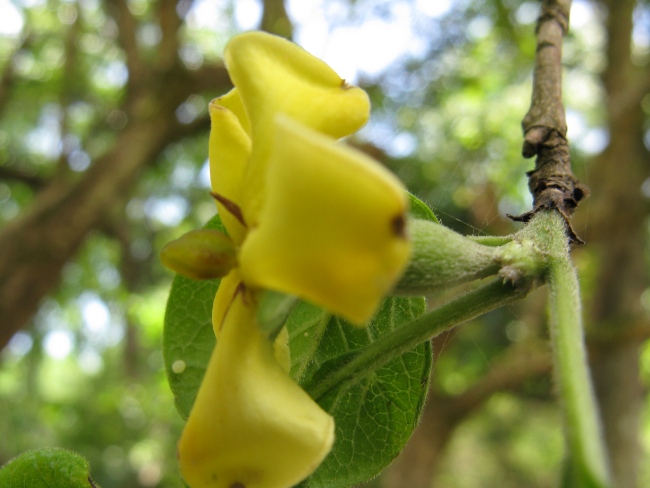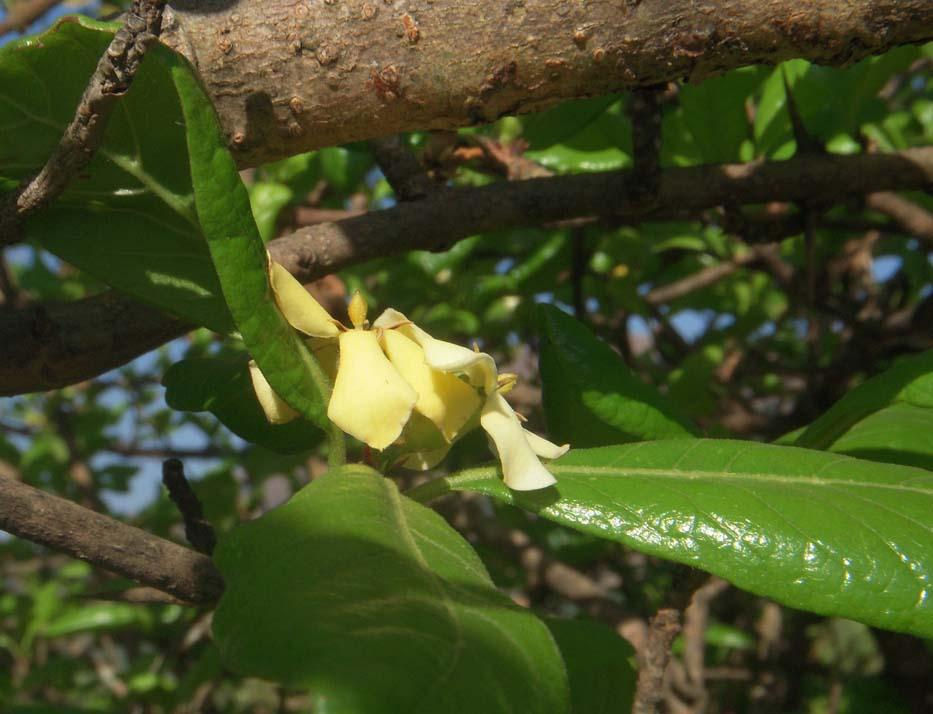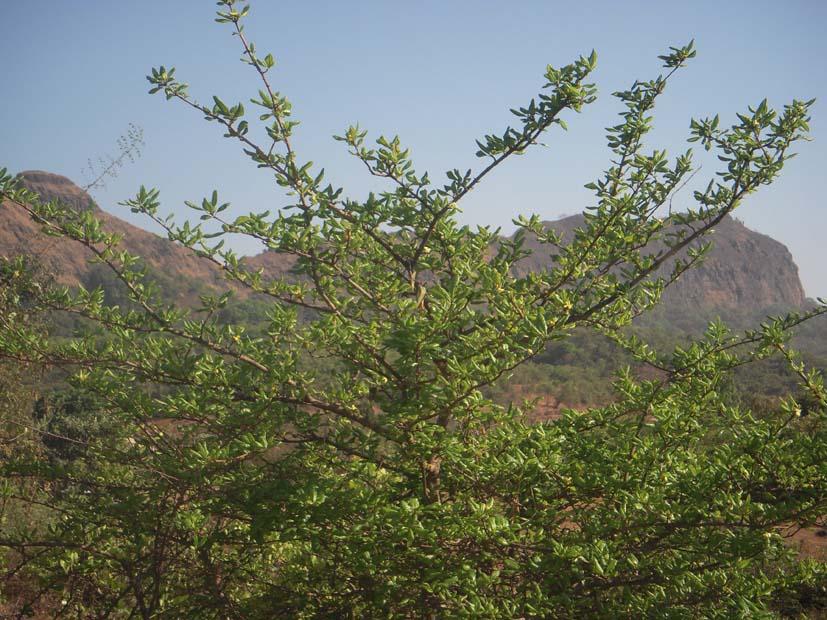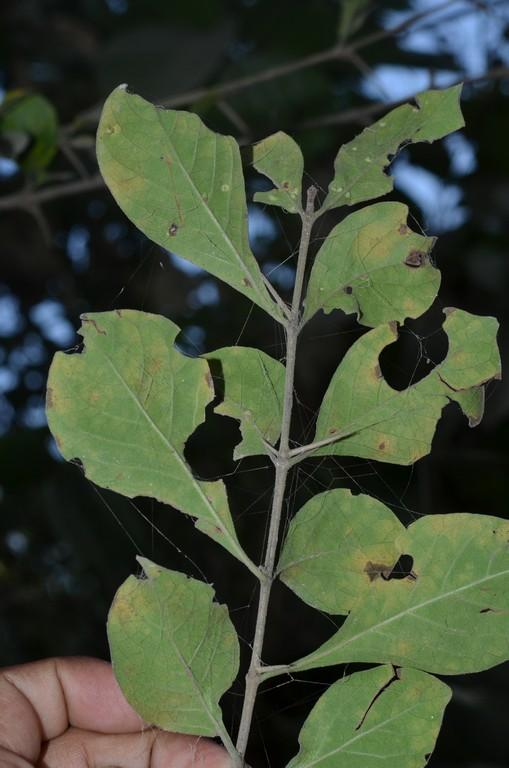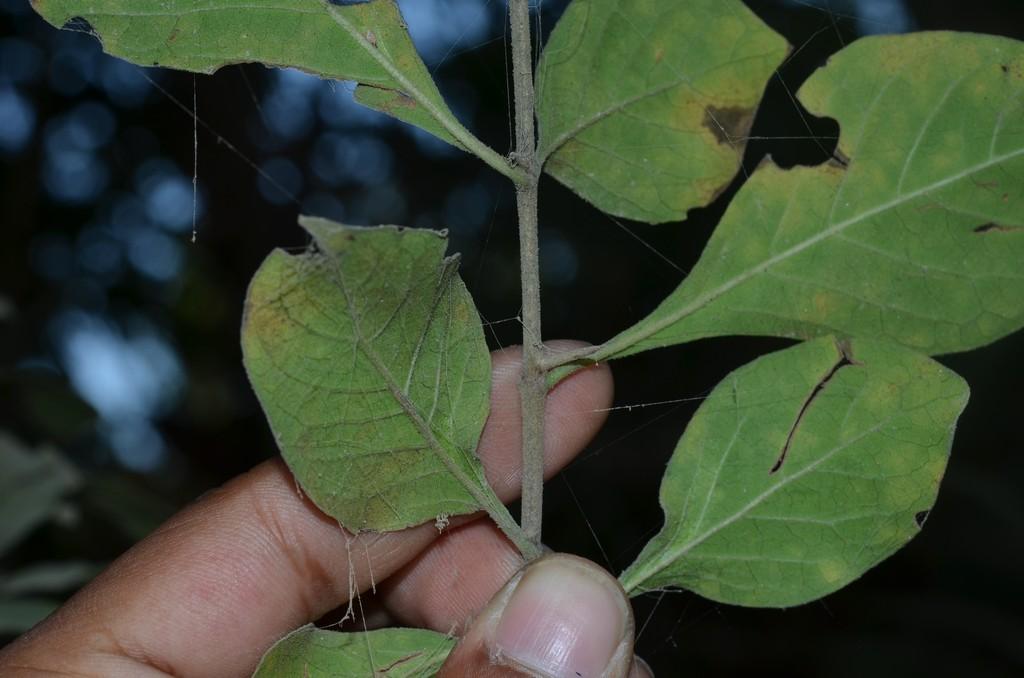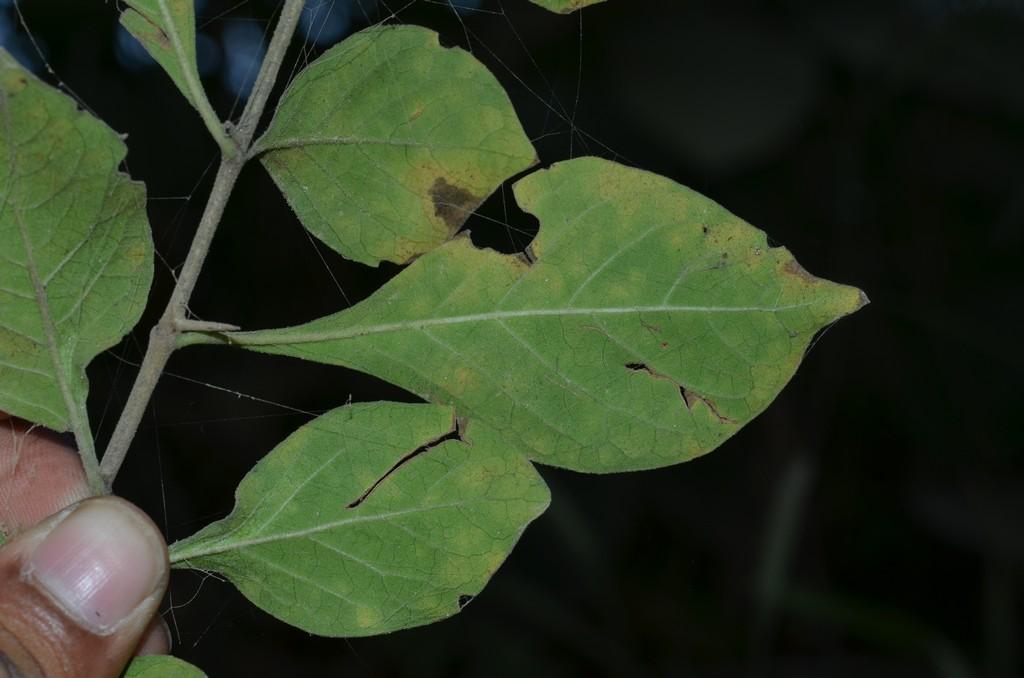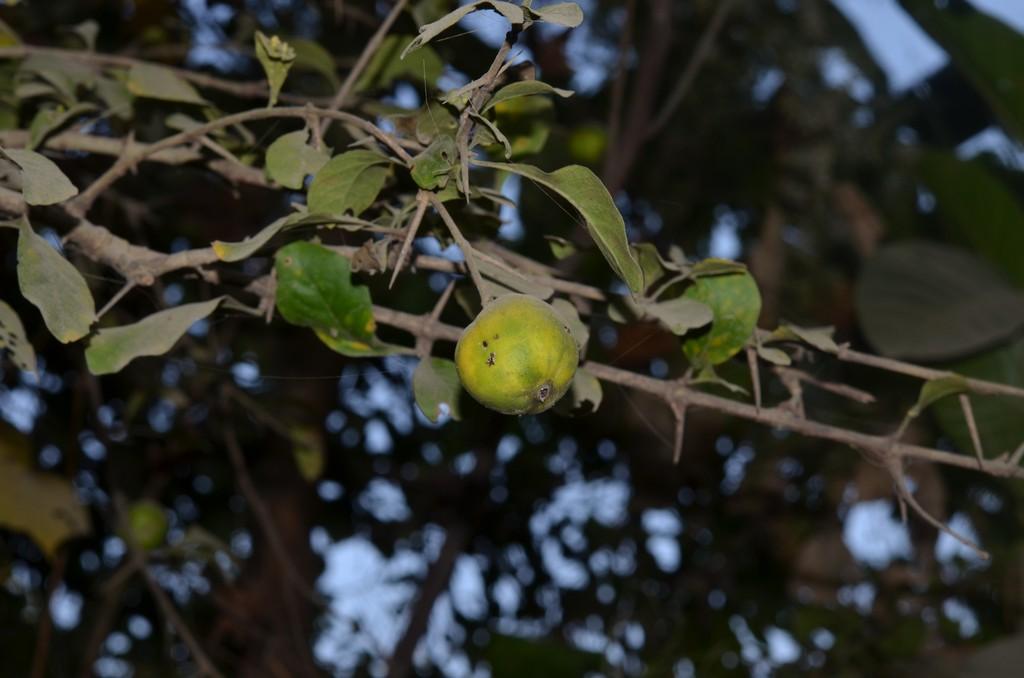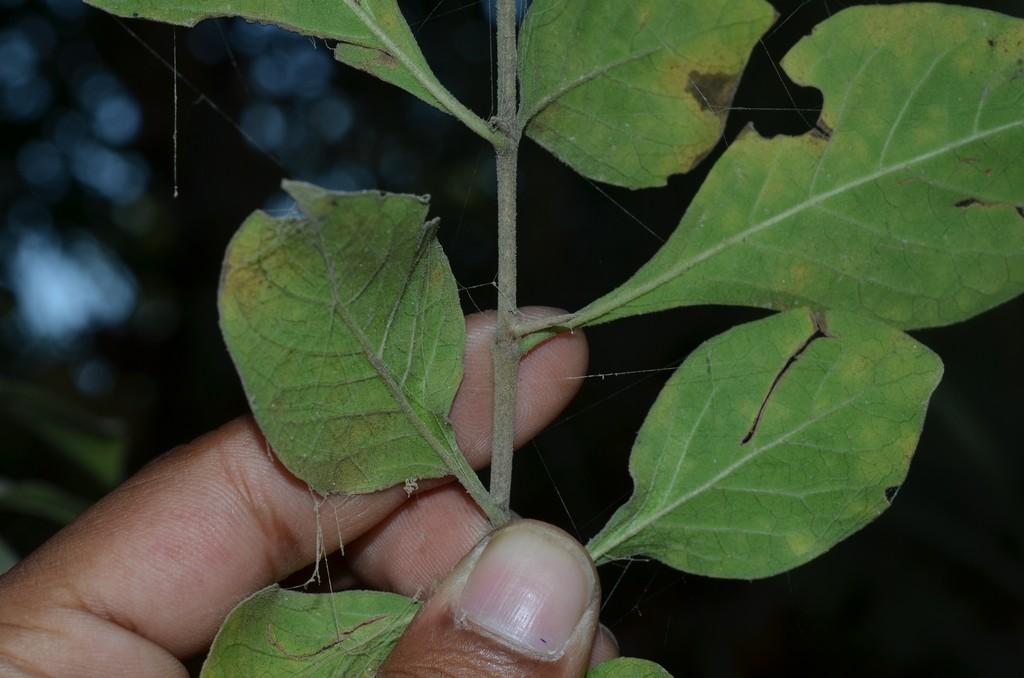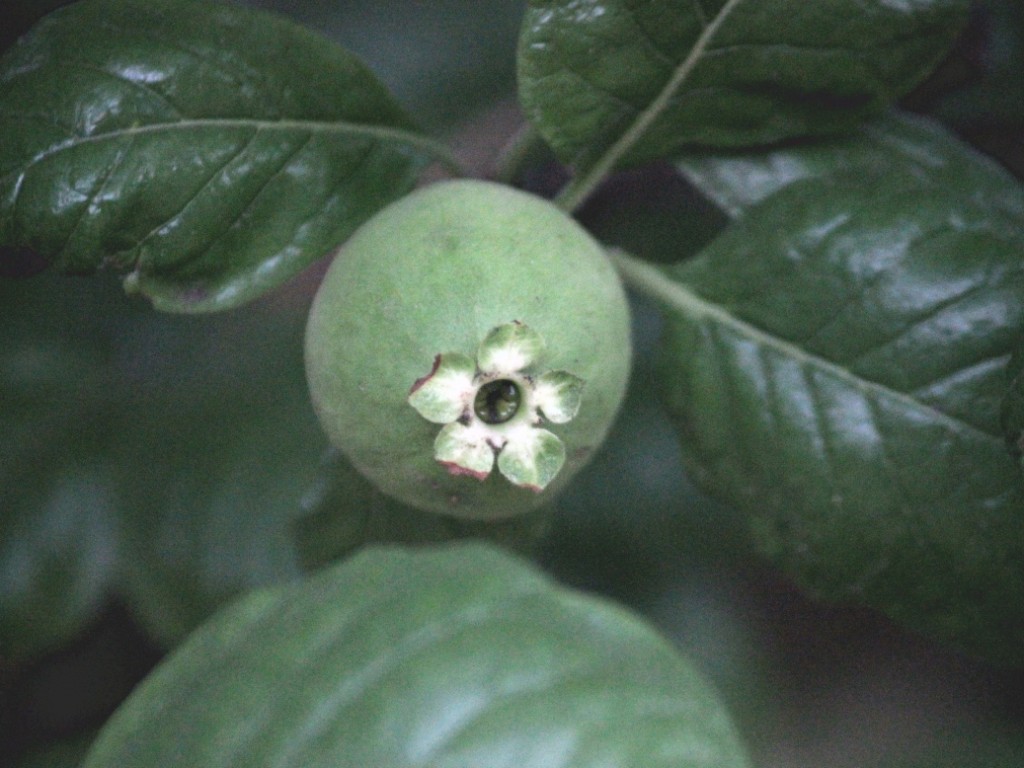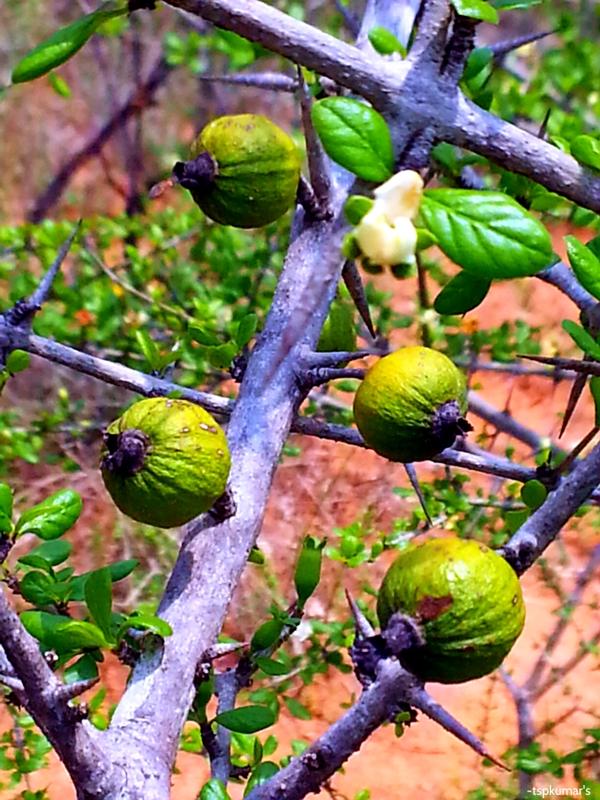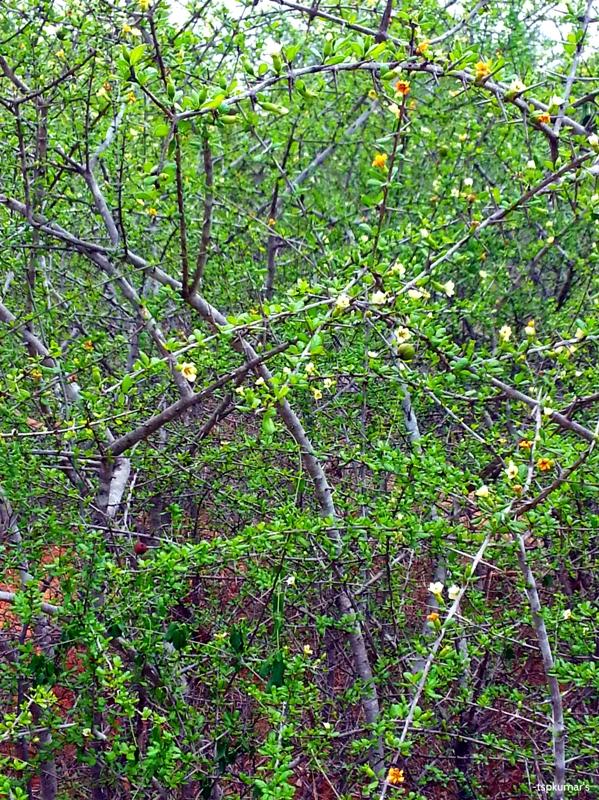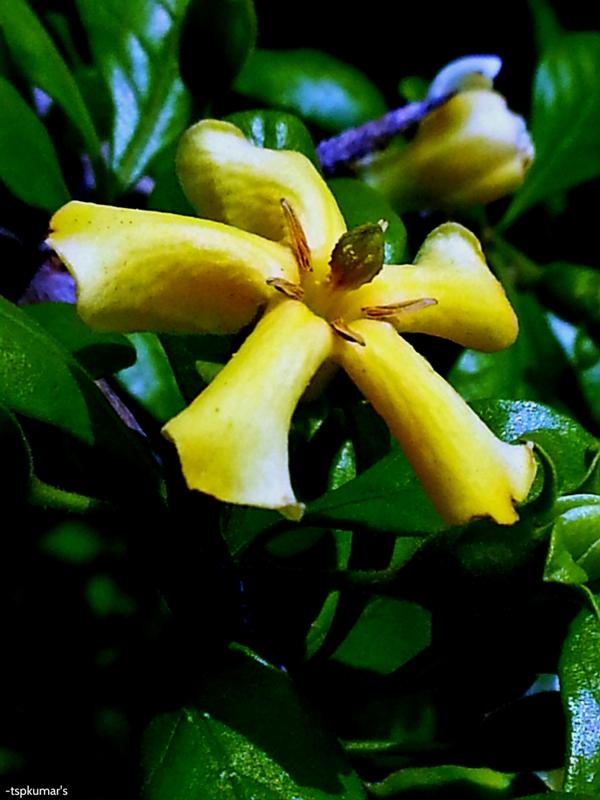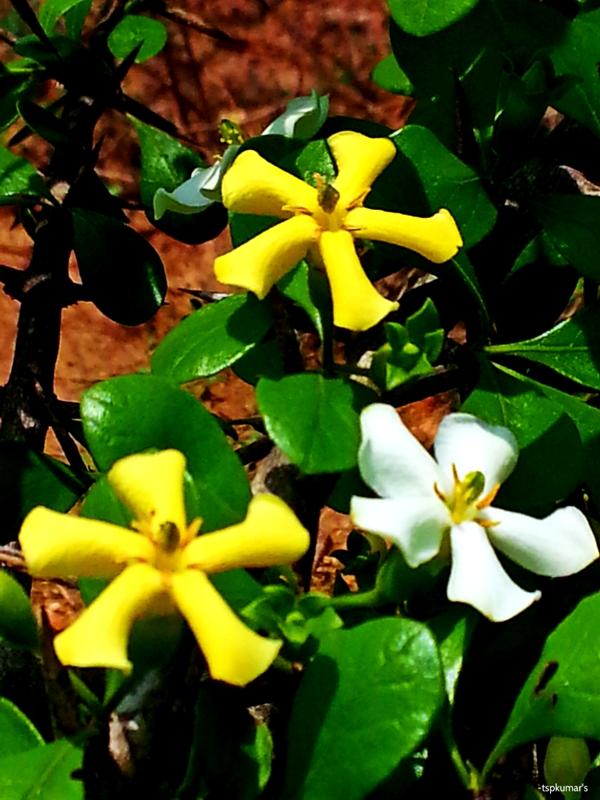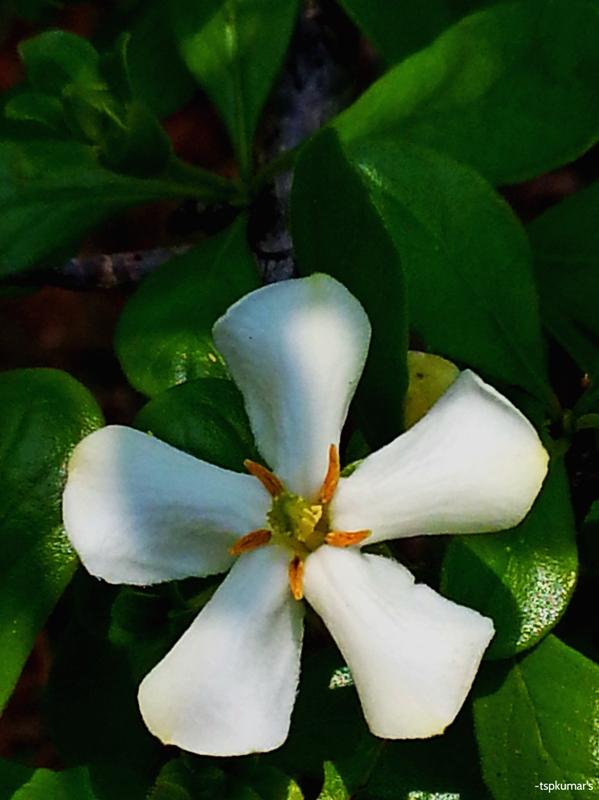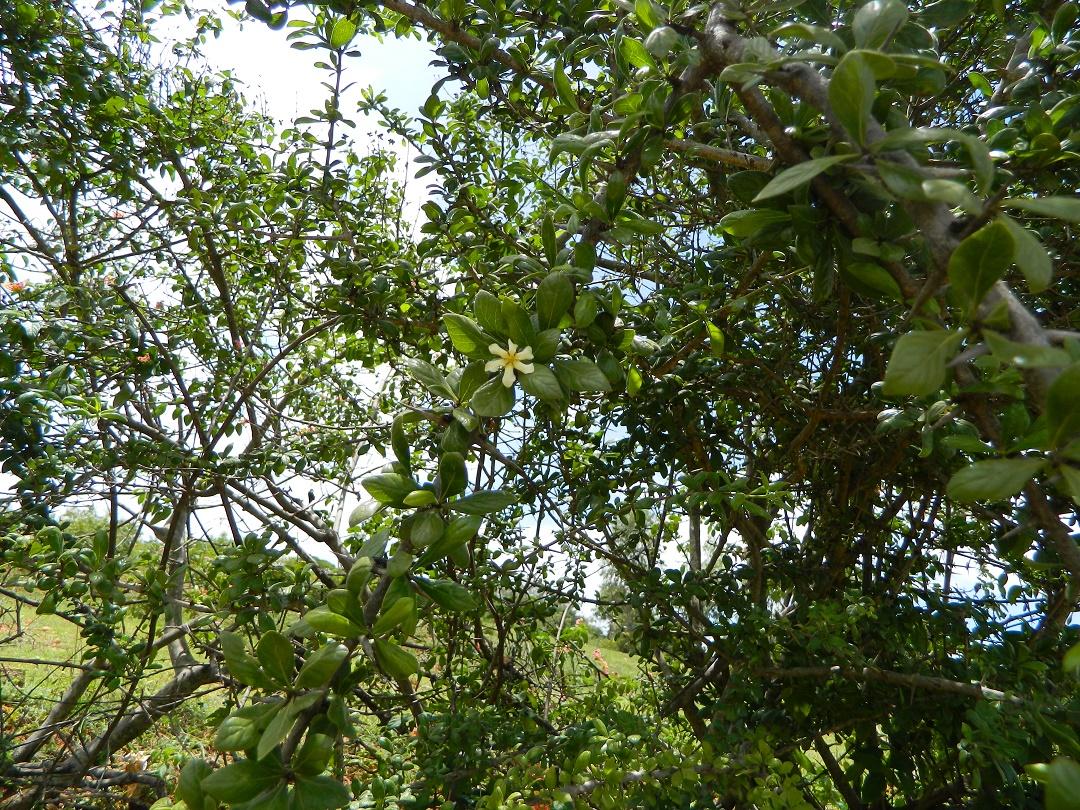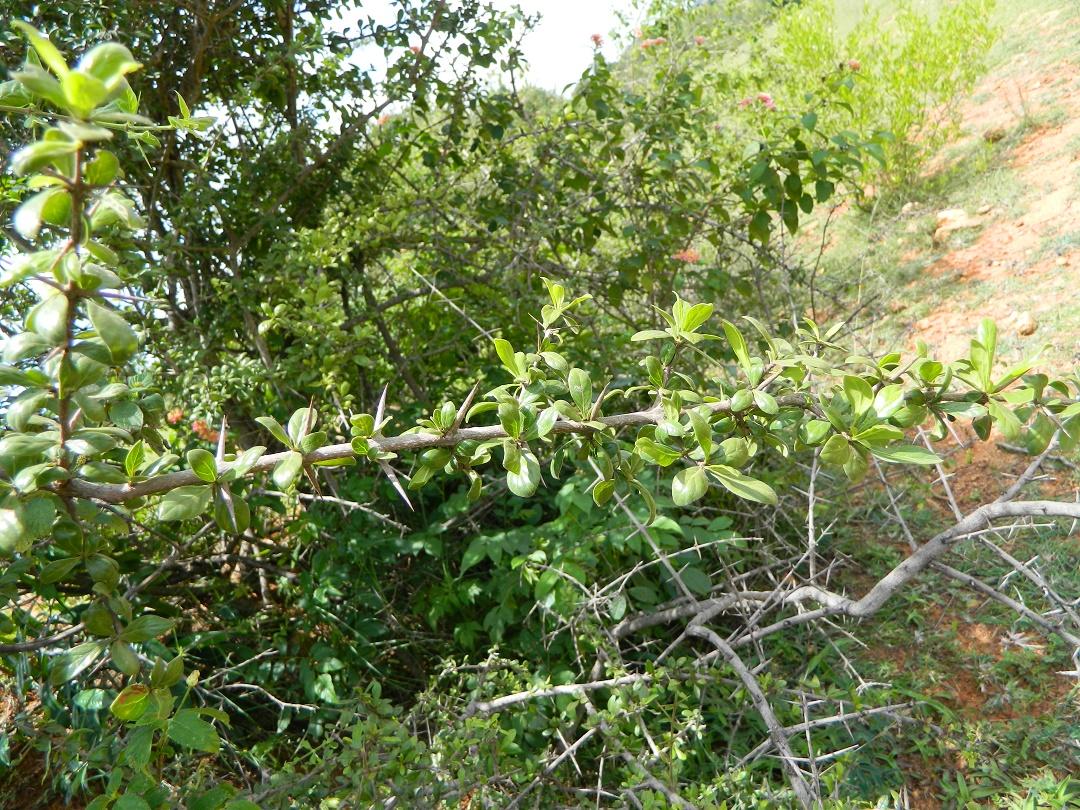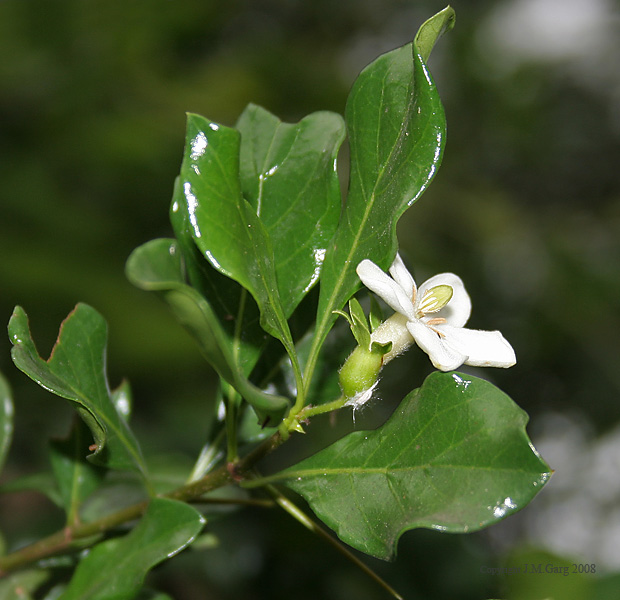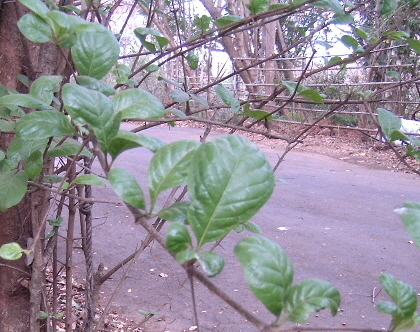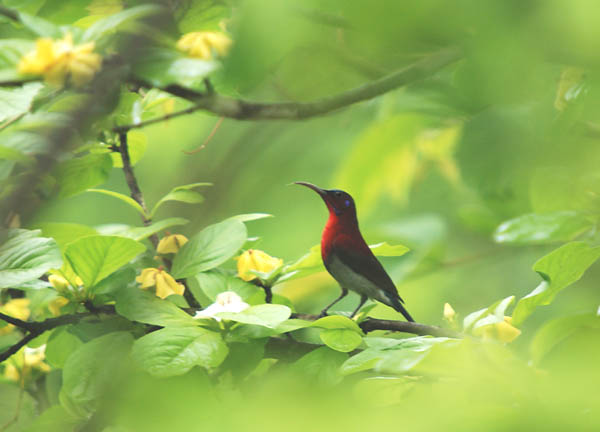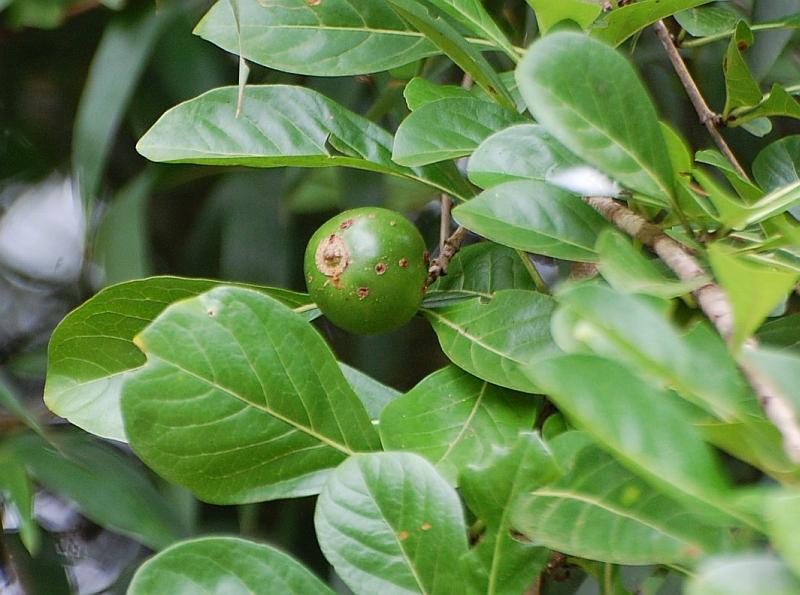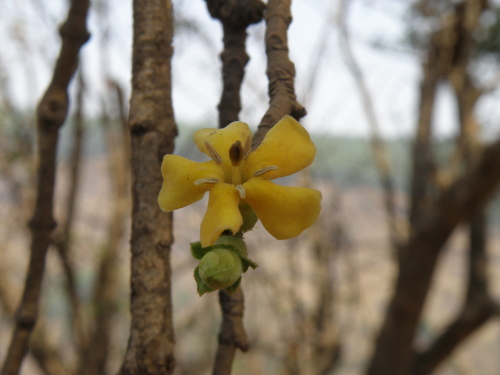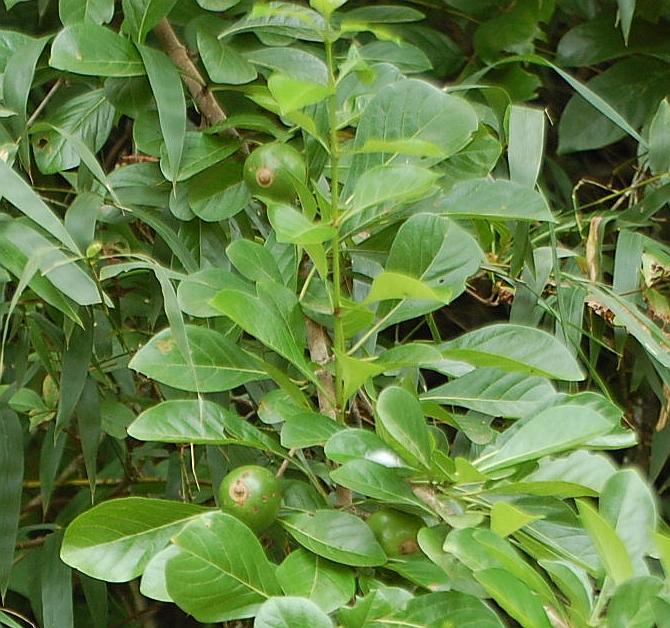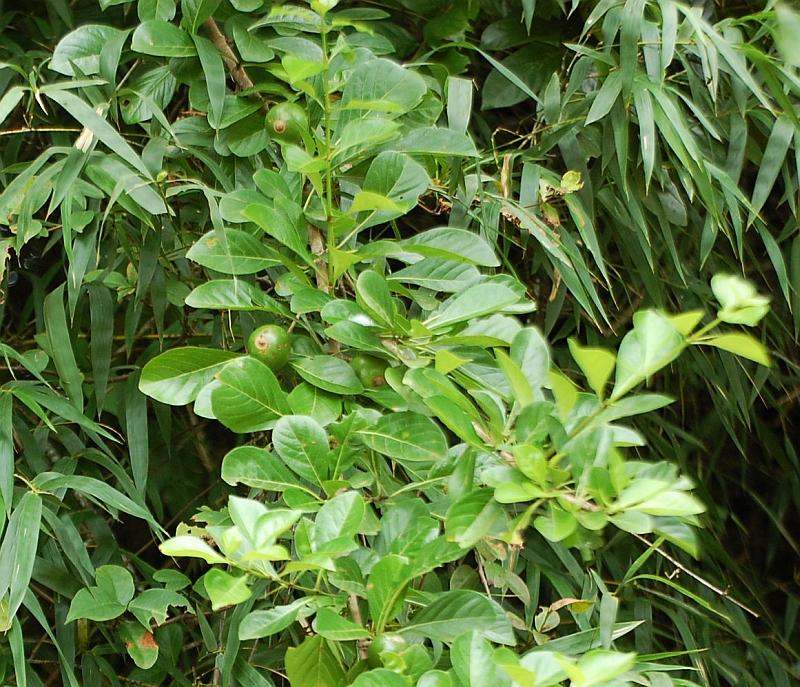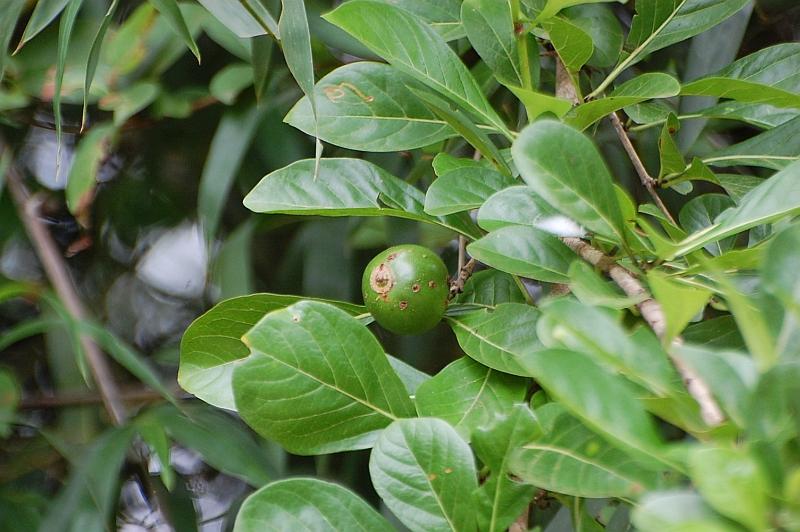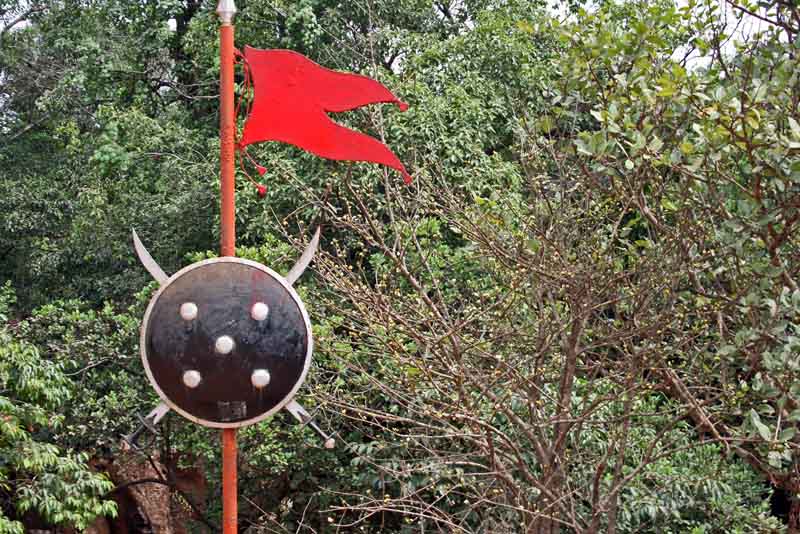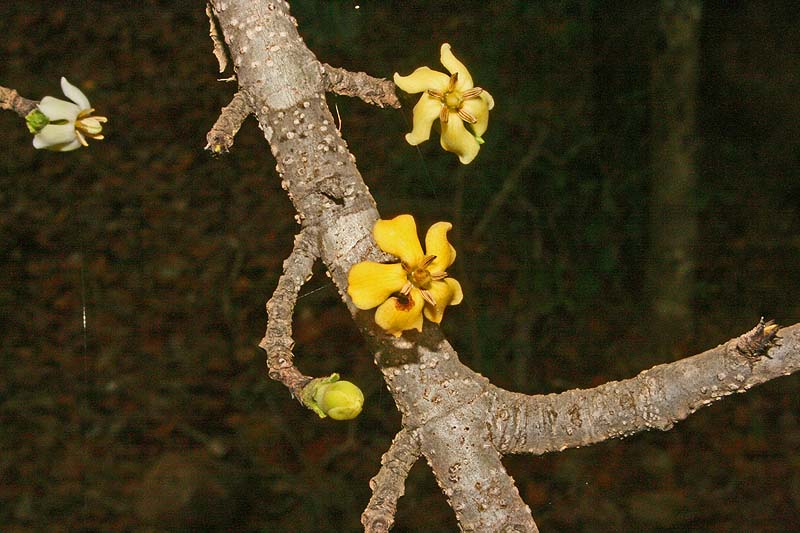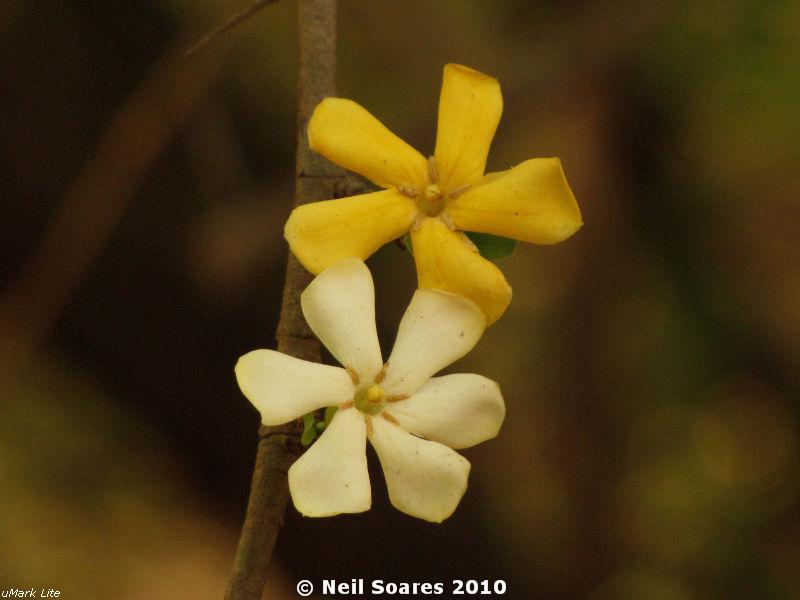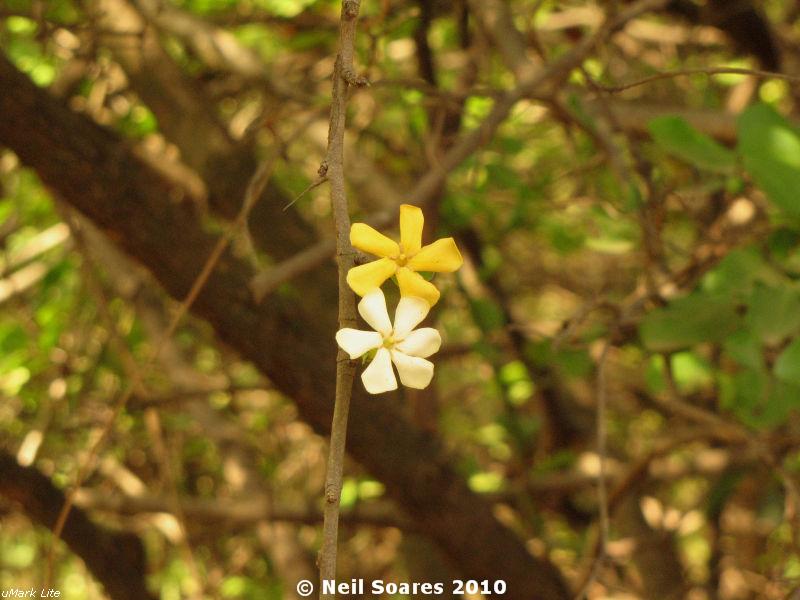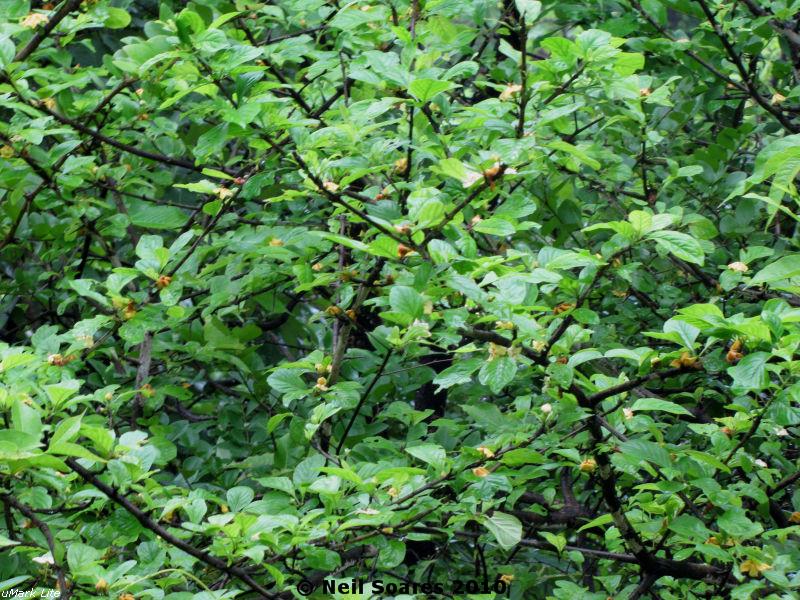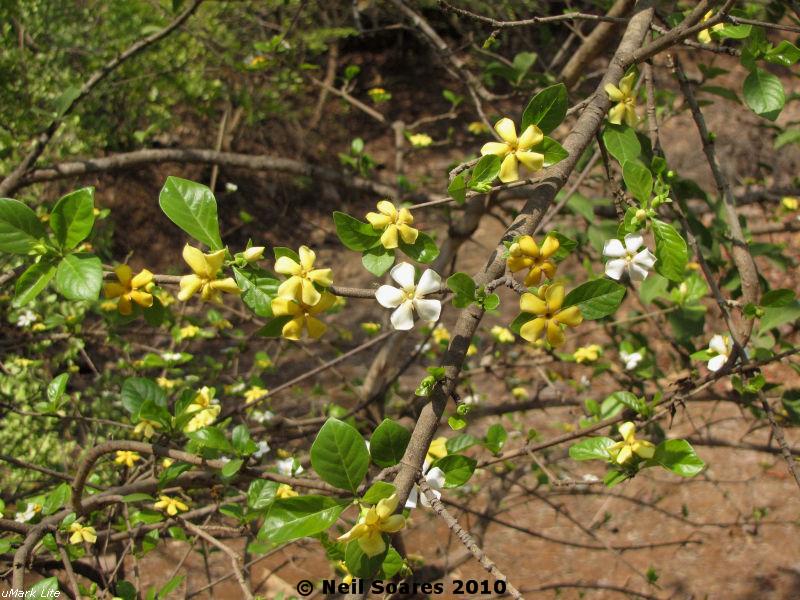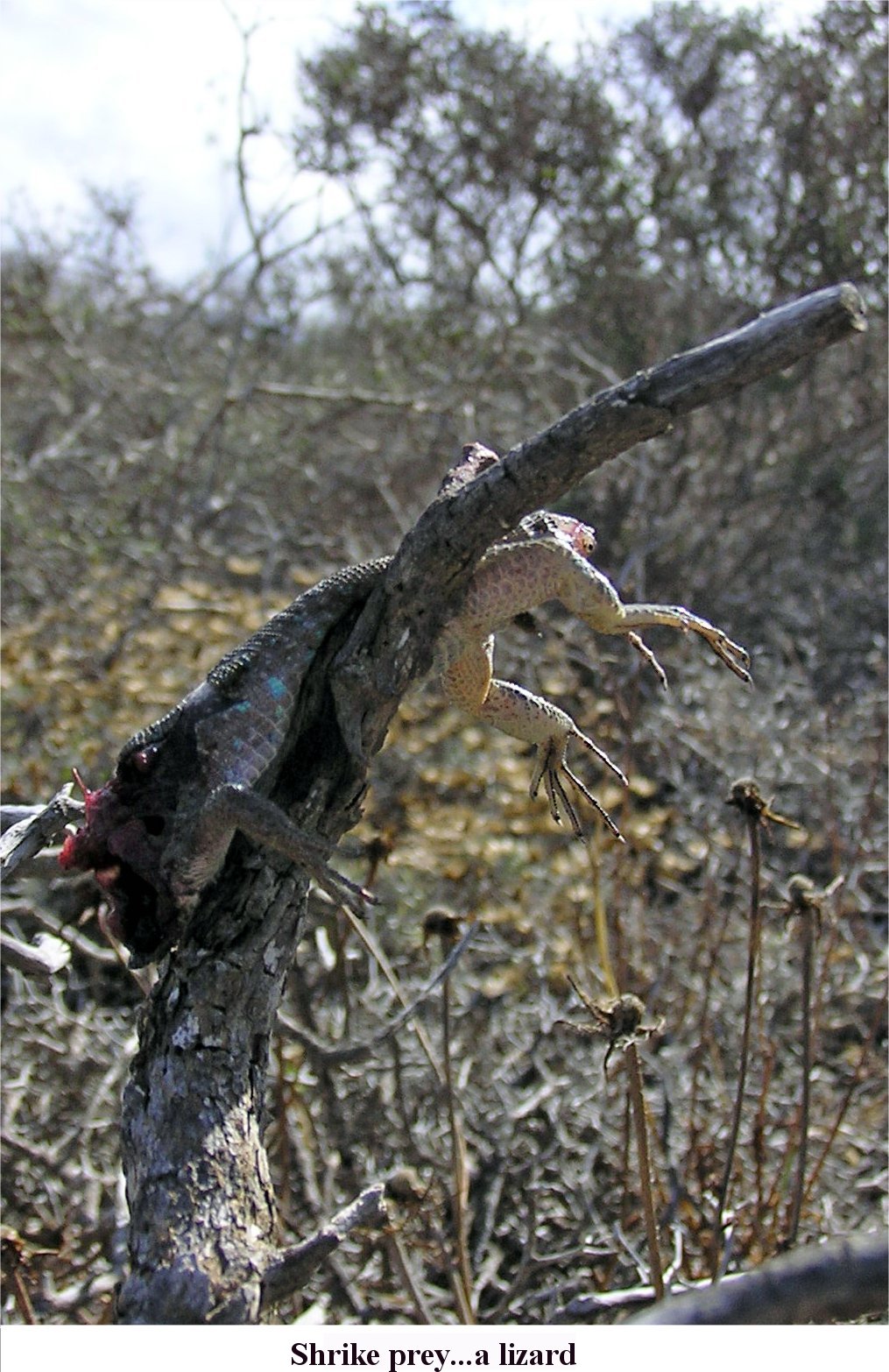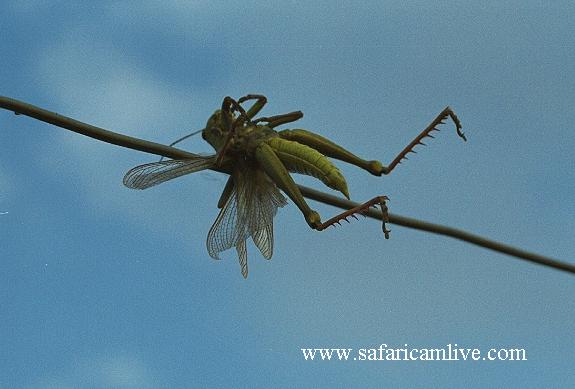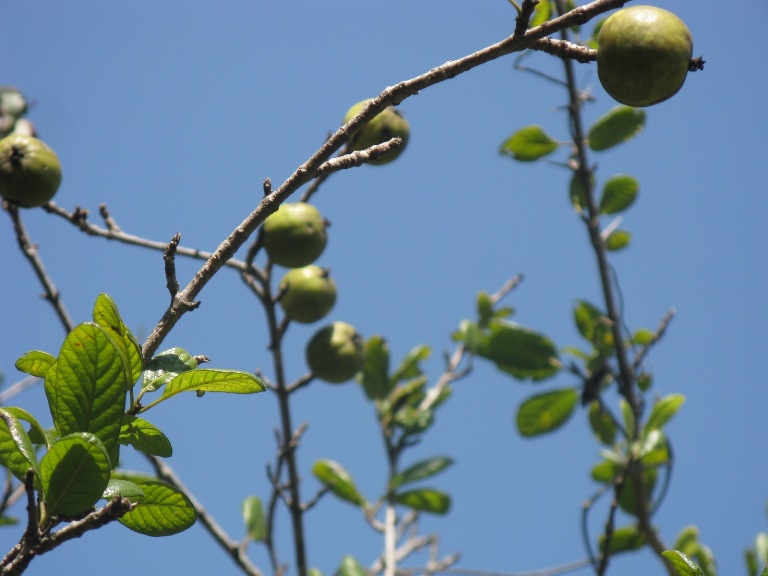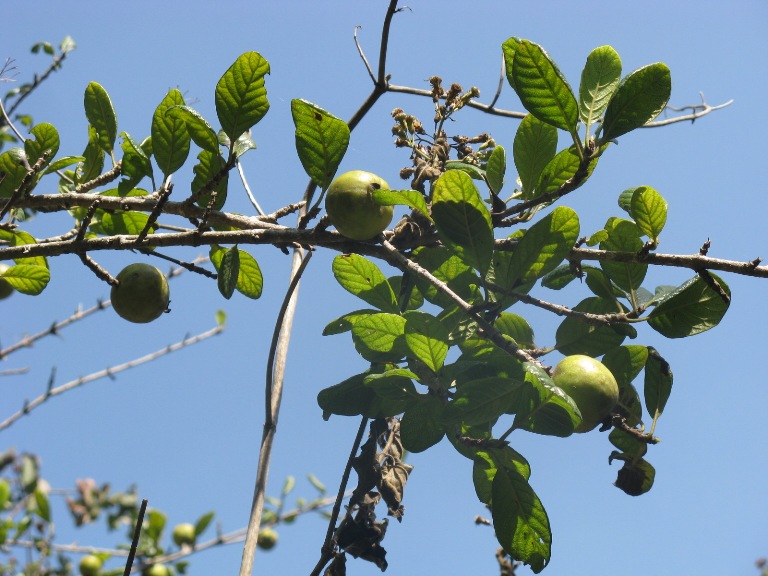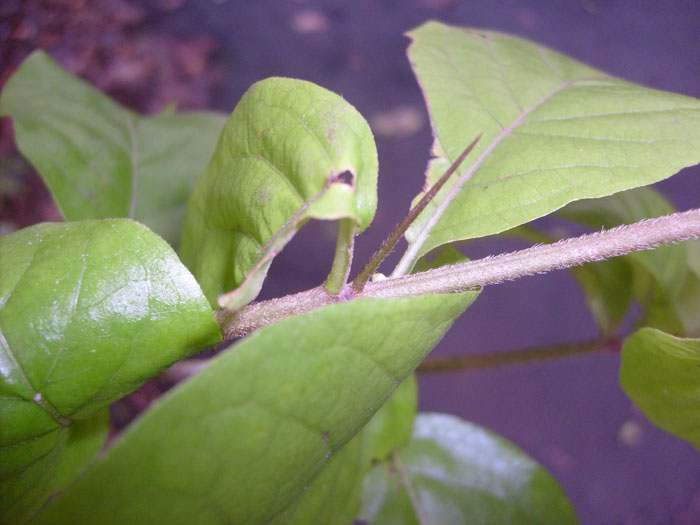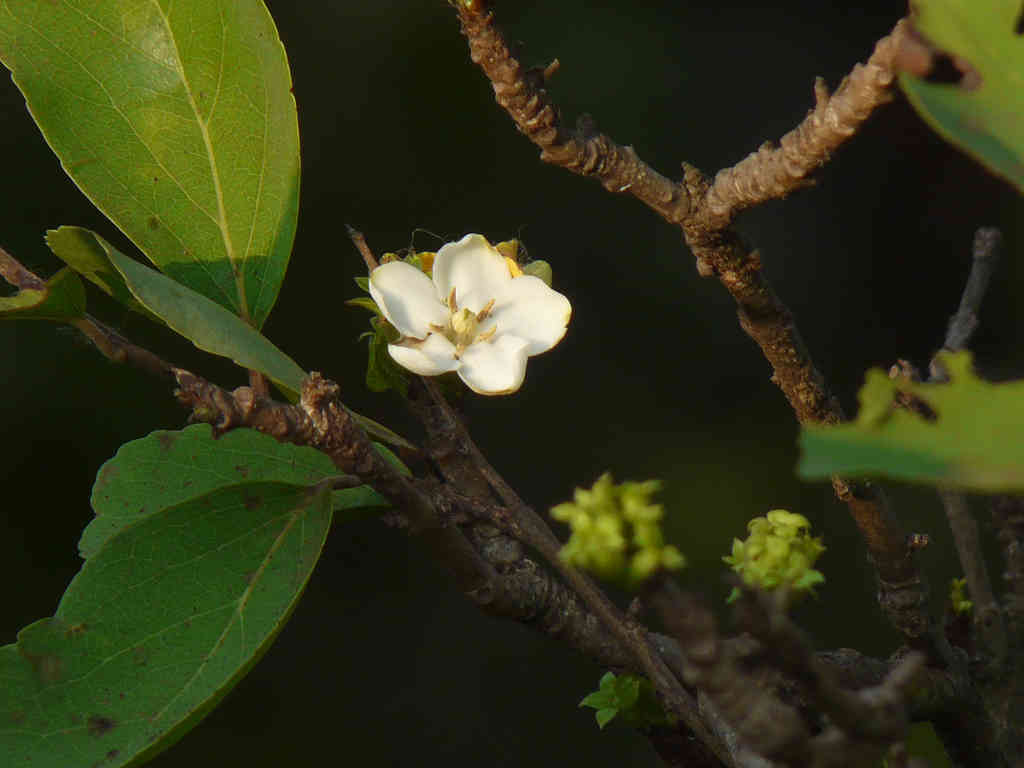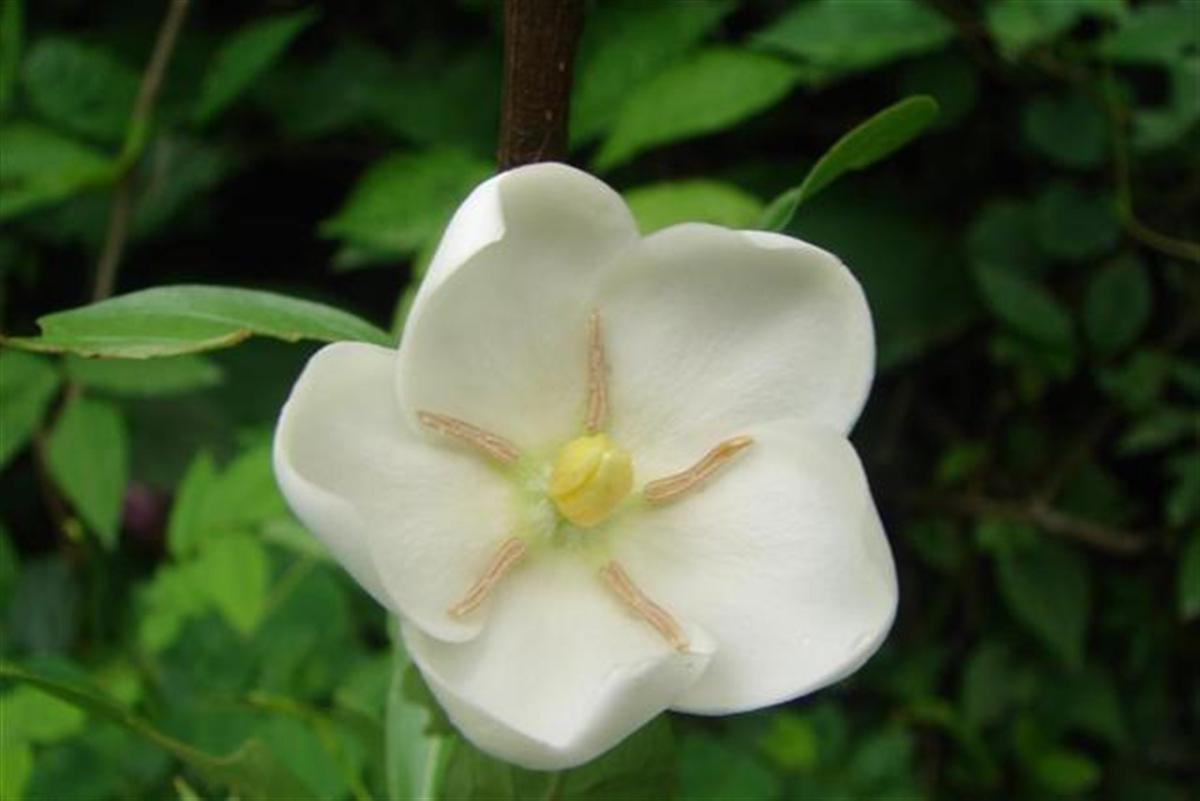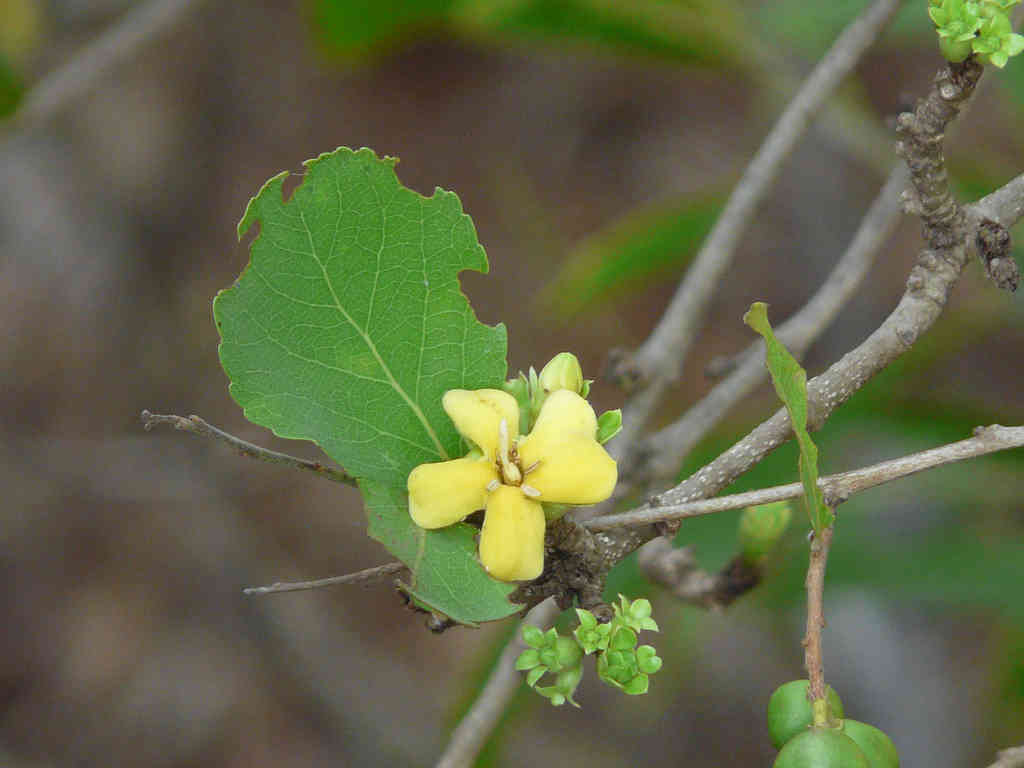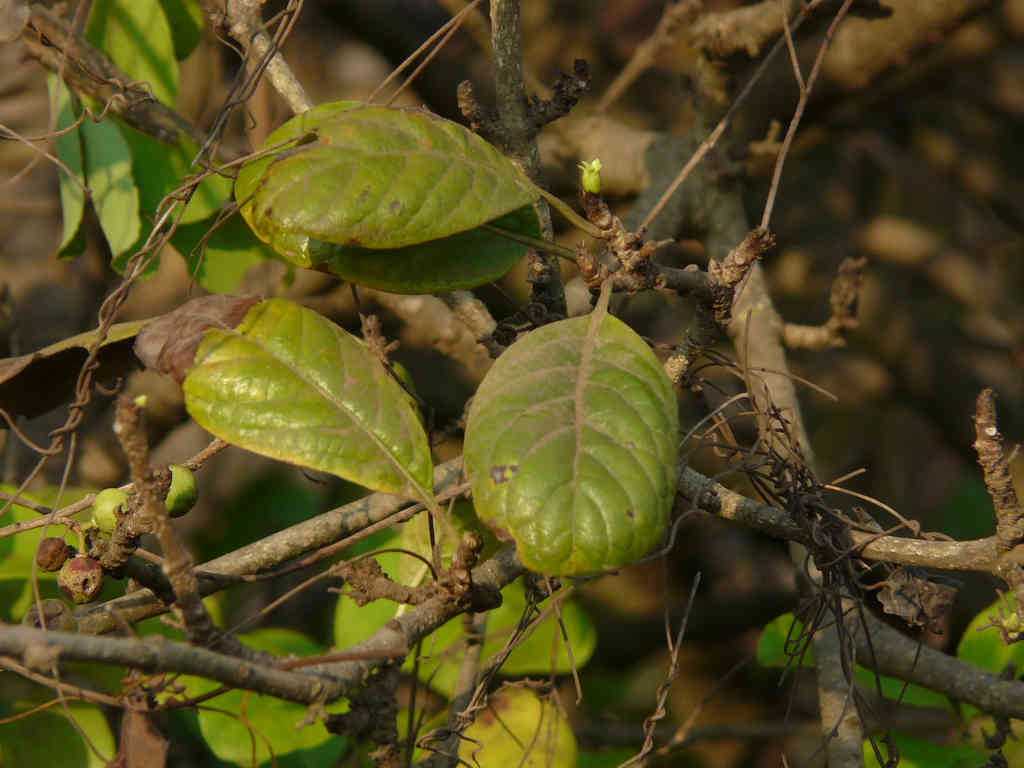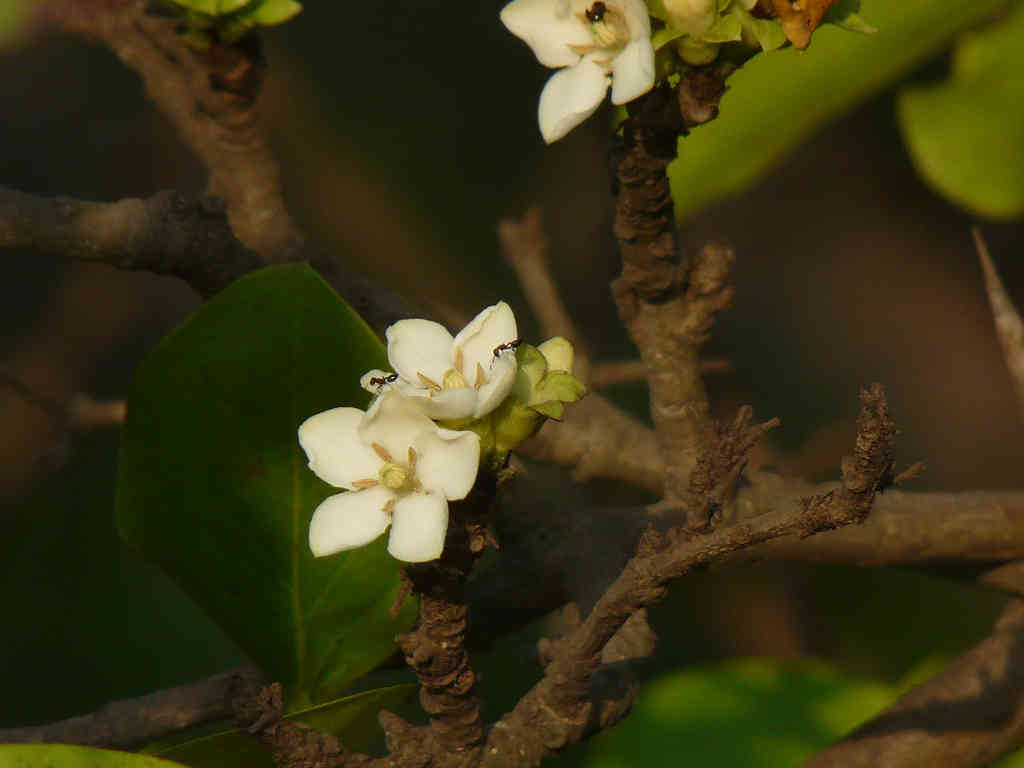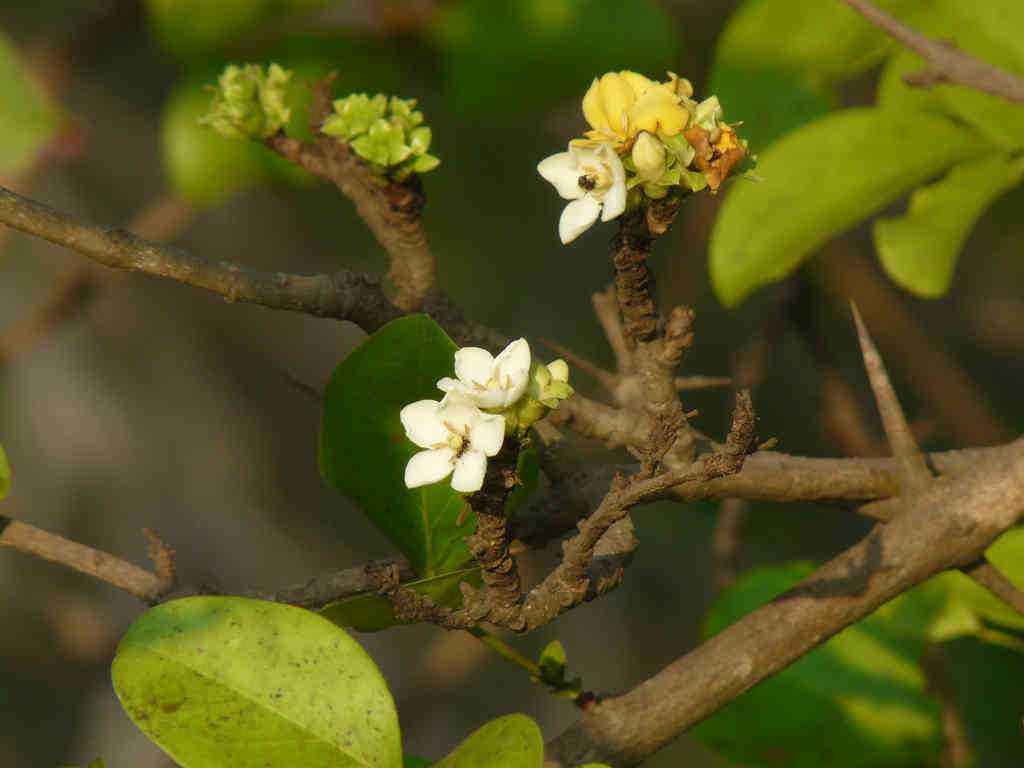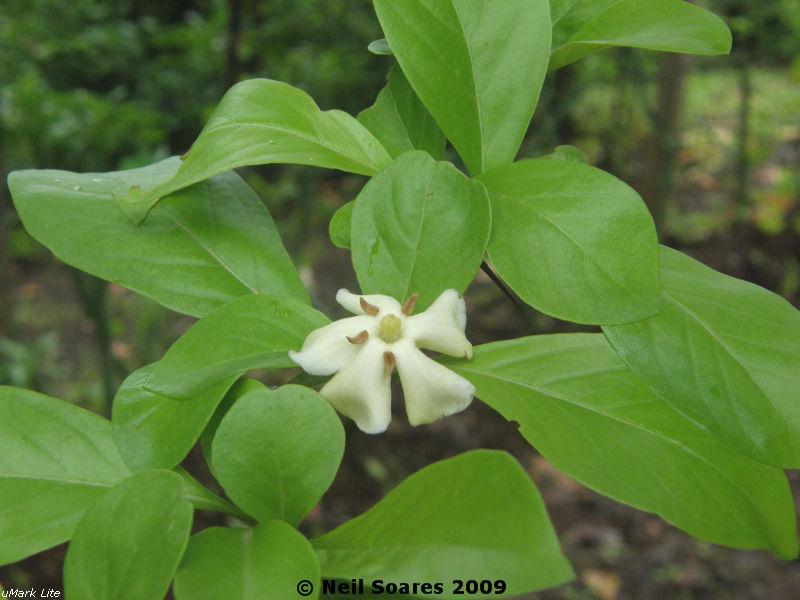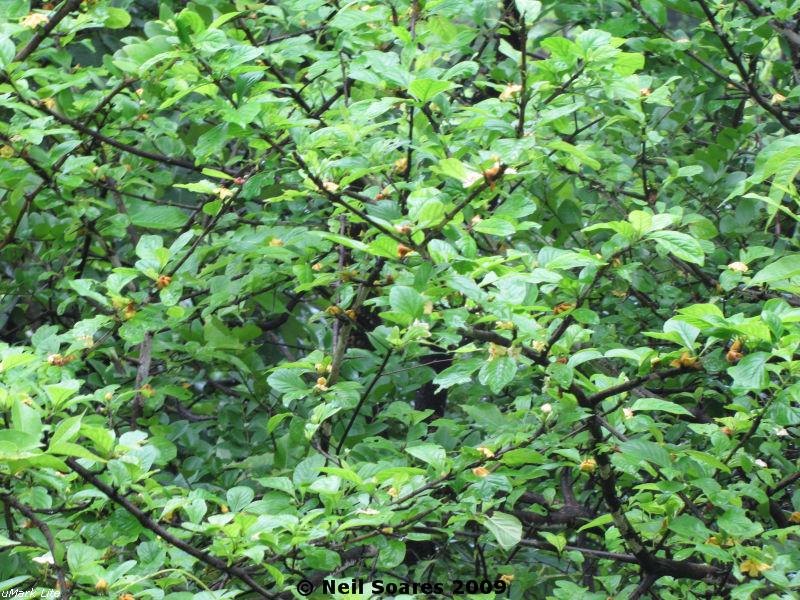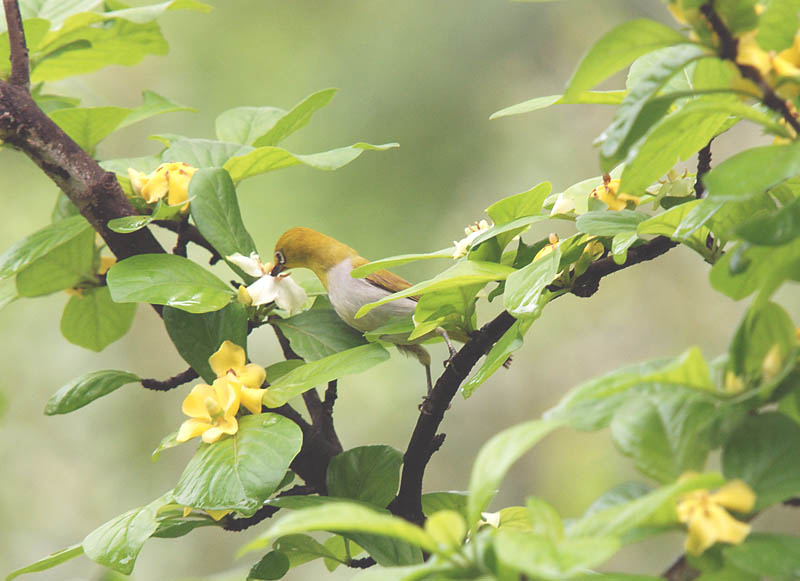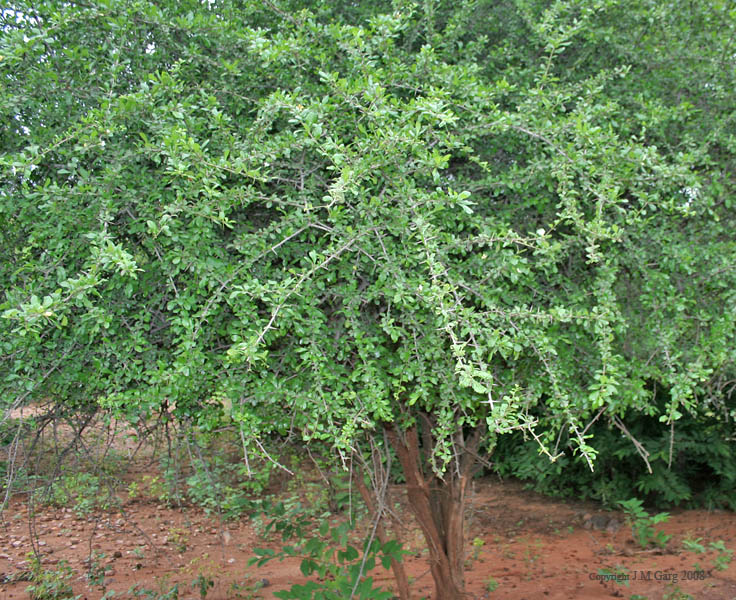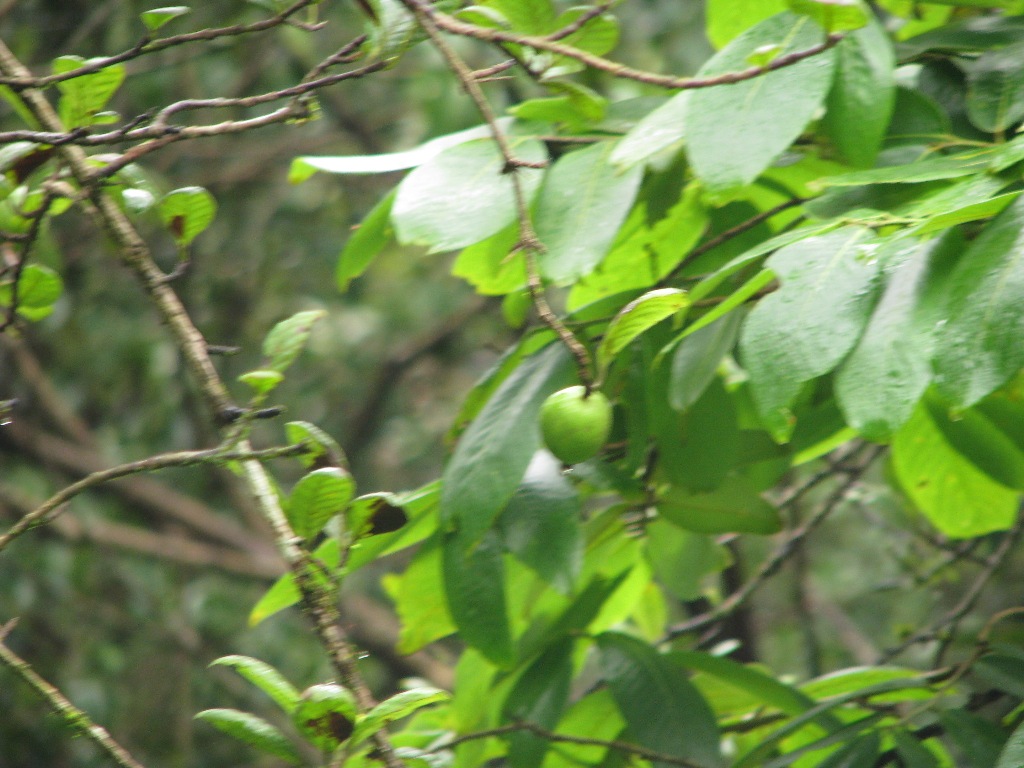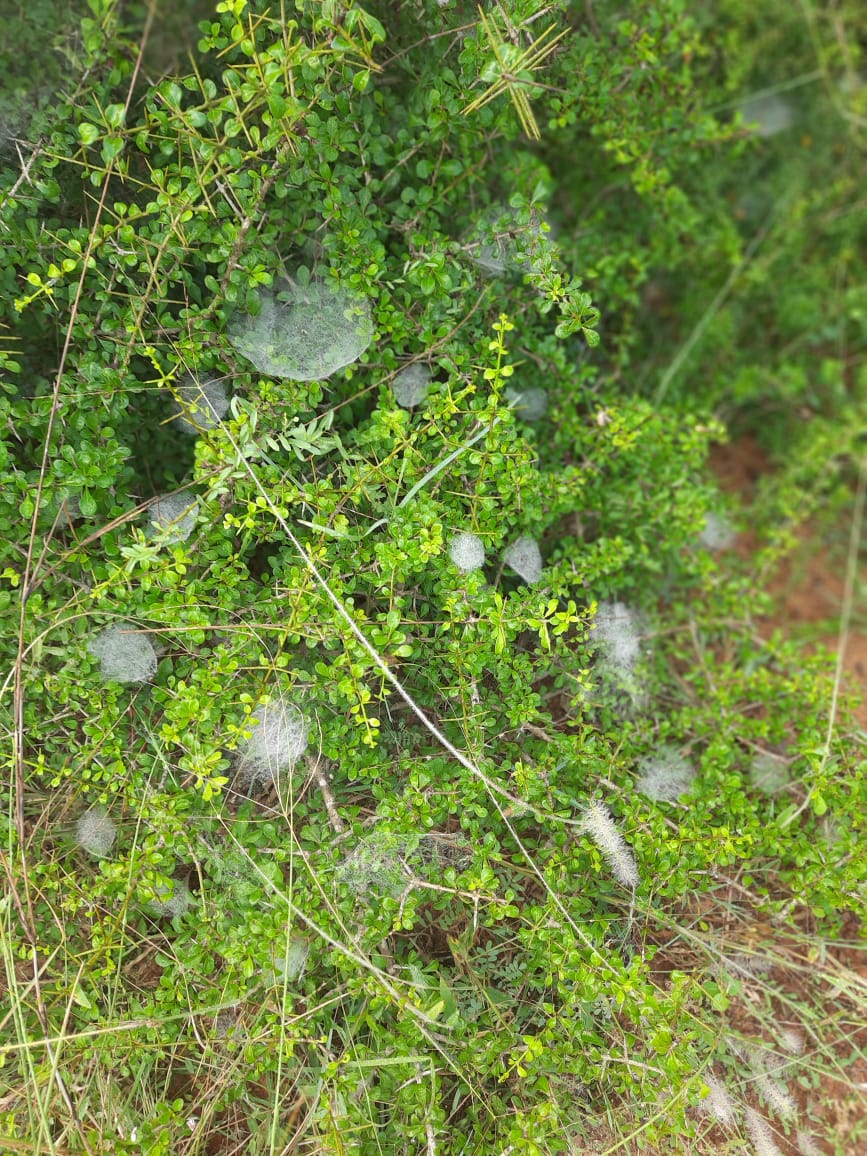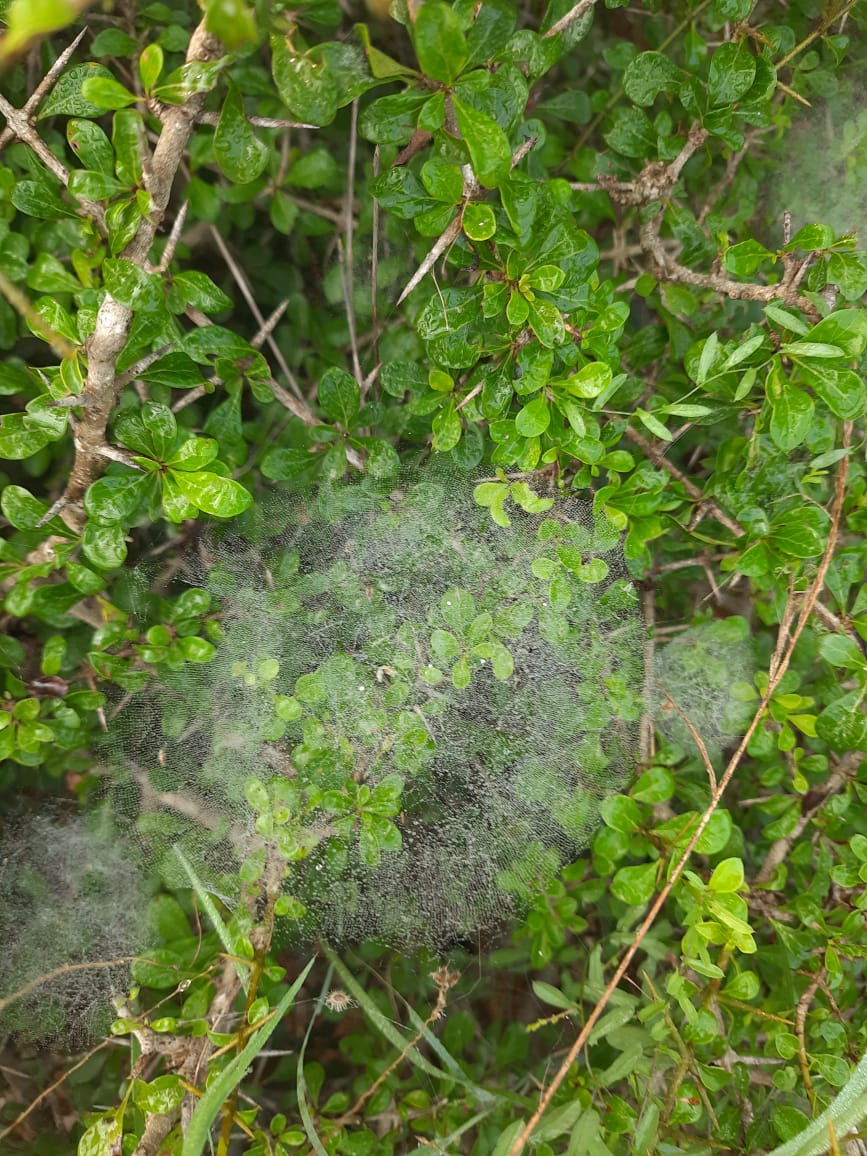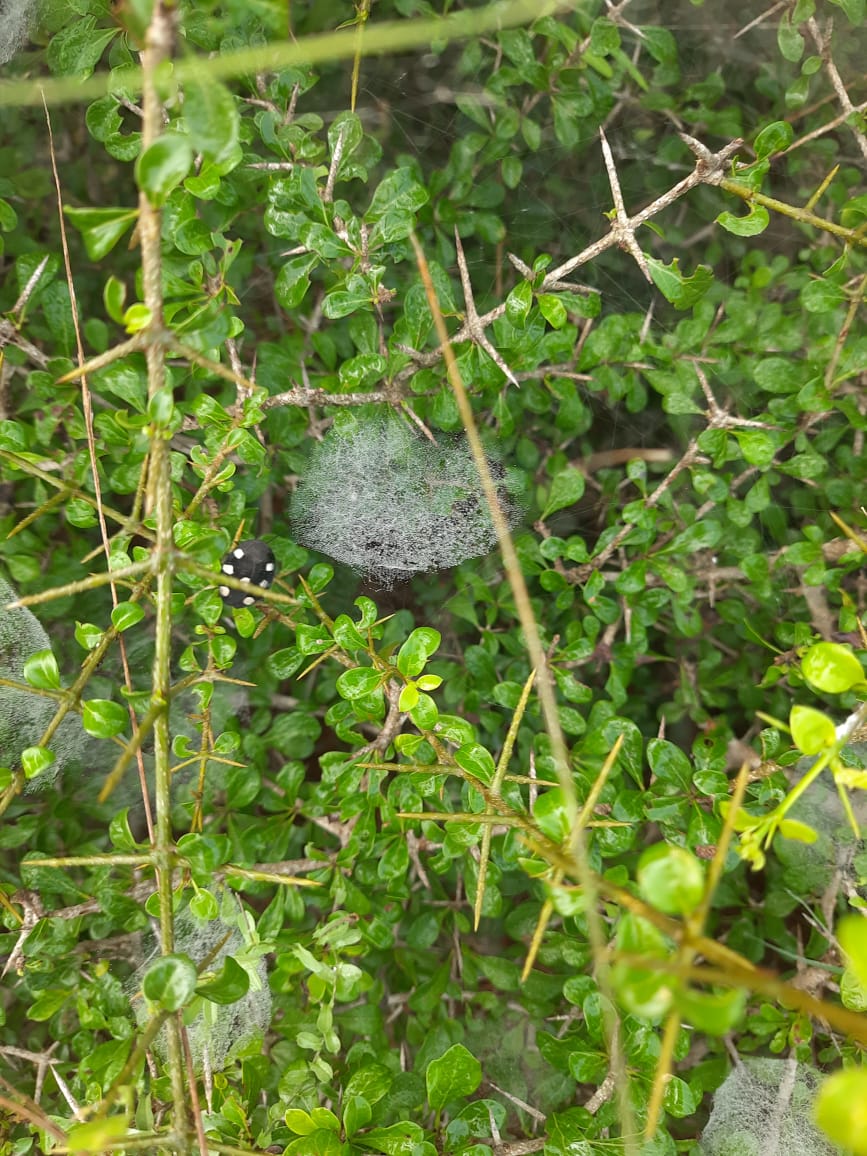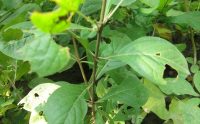|
Catunaregam spinosa (Thunb.) Tirveng., Bull. Mus. Natl. Hist. Nat., Sér. 3, Bot. 35: 13 1978. (syn. Canthium chinense Pers.; Canthium coronatum Lam.; Ceriscus malabaricus Gaertn.; Gardenia dumetorum Retz.; Gardenia dumosa Salisb.; Gardenia floribunda Roxb. [Invalid]; Gardenia glabra R.Br. ex Wall. [Invalid]; Gardenia latifolia Schltdl. ex Hook.f. [Illegitimate]; Gardenia spinosa L.f. [Illegitimate]; Gardenia stipularis Rottler; Gardenia spinosa Thunb.; Genipa dumetorum (Retz.) Baill.; Narega coduva Raf.; Posoqueria dumetorum (Retz.) Willd. ex Roxb.; Posoqueria floribunda Roxb.; Randia brandisii Gamble [Illegitimate]; Randia dumetorum (Retz.) Lam.; Randia floribunda (Roxb.) DC.; Randia lachnosiphonium Hochst.; Randia oxypetala Lindl.; Randia rottleri Wight & Arn.; Randia spinosa (Thunb.) Poir.; Randia spinosa (Thunb.) Blume; Randia stipulosa Miq.; Randia tomentosa Wight & Arn.; Solena dumetorum (Retz.) D.Dietr.; Solena floribunda (Roxb.) D.Dietr.; Solena longispina D.Dietr.; Solena nutans D.Dietr.; Xeromphis obovata (Hochst.) Keay; Xeromphis retzii Raf.; Xeromphis spinosa (Thunb.) Keay ….; (=) Randia dumetorum (Retz.) Poir.); Catunaregam spinosa: – Wow so beautiful.. these plants in Amboli are covered by lot of Dendrobium.. different species of it:):) identification no060311sn3: – Catunaregam spinosa Ceriscoides turgida: – Absolutely Catunaregam spinosa as said by .. – It looks like catunaregum spinosa. Initialy fls are white , later turns into yellow colour. ID Request 24082011mc01:
Another ID request. Separate shots of flower and fruit sent. Locality: About 40 km from Chennai
Altitude: Sea level Habitat: Thorny bush to small tree Approximate Height: 10-15 feet Photo taken on: 14th August, 2011 Nice Pictures! Yes Catunaregam spinosa (Thunb.) Tirveng. of Rubiaceae family. Madanphal… an important emetic, and pitta-nashak oushadhi…. Yes Catunaregum spinosa, Gela in Marathi and Madanphal in Sanskrit. .
Catunaregam spinosa flowering:
False Guava: Interesting and nice pics. Is it edible? I am not sure… somewhere read the unripe fruit is used as Fish poison and somewhere I read that this has medicinal value. May be someone else can throw light on this. Pl. find the attached file contain photos for id. request.
Location: NBNP Anaikatti, Coimbatore Dist.
Date: 22.12.2011
Habitat: Wild
Habit: Tree Catunaregam spinosa (Rubiaceae). Tamil names: Madhukkaarai, Marikkalaan Yes … is right. This is Catunaregam spinosa, the wild edible fruit plant in most of the tribal dominated districts of Odisha. Thanks … In some parts of TN, it is said to be used as a fish-stupefying agent. KAS Week:: (Catunaregam spinarum – 04/10/2012 – NJ): KAS Week DS_101012_01 Tree that named KAS plateau:
Today’s postings are my last episode of KAS. The tree Kas- for which the plateau is named. This is Catunaregam spinosa. The local name as far as I know is Ghela. My photographs of this tree are available in the archives of this group. Kas is said to be named after Elaeocarpus glandulosus which is called Kasa in marathi. The plant in picture seems Catunaregam or Gela in marathi. .
Rubiaceae Week :: Catunaregam spinosa from Coimbatore: Rubiaceae Week :: Catunaregam spinosa at TWLS and Mahabaleshwar:
Catunaregam spinosa (Thunb.) Tirveng. kah-too-NAH-rain-gum — from Tamil kātu (scrub forest), nārangkam (Mandarin orange)
spy-NO-suh — with spines Jun 28, 2008 … at Tungareshwar Wildlife Sanctuary, Maharashtra
commonly known as: false guava, mountain pomegranate, spiny randia, thorny bone-apple • Assamese: behmona, gurol, mona • Bengali: karhar, mainphal • Gujarati: મીંઢળ mindhal • Hindi: मैनफल mainphal • Kannada: ಕಾರೆಕಾಯಿ ಗಿಡ kaarekaayi-gida, ಮಗ್ಗಾರೆ maggaare • Kashmir: मैनफल mainphal • Khasia: diengmakasing-khlaw • Lushai: sazuk thei • Malayalam: മലങ്കാര malankaara • Marathi: गेळ gela, खाजकांदा khajkanda, पेरअळू peralu • Oriya: palova, patova • Sanskrit: मदन madan, पिण्ड pinda, शल्पक shalpaka • Tamil: மதுக்காரை matukkarai, மருக் காண mruk kana, முள்ளுக்காரை mullukkarai • Telugu: మందాచెట్టు mandacettu, మంగ manga, మ్రంగ mranga, పిండీతకము pinditakamu Native to: India, south tropical Africa, southern Africa References: Flowers of India • eFlora • Flowers of Sahyadri by Shrikant Ingalhalikar more views: Jun 28, 2008 … at Tungareshwar Wildlife Sanctuary, Maharashtra Feb 16, 2008 … at Mahabaleshwar, Maharashtra Rubiaceae week: Catunaregam spinosa from Arsikere, Karnataka: Nice set of photos …,
Humans use – C.spinosa fruits are crushed and used as soap to wash clothes, they turn frothy when mixed with water and agitated. About faunal interdependance we need to study carefully We are heading to the same forest again on 19 th Feb. You must join us and carry on the good work of documenting floral species. Thanks … for sharing the nice photographs and … for the valuable info. This is very common in Tamil Nadu scrub jungles.
Manga Kai / Kaare kai – used to lure fish on the water surface: Common emetic Nut
Telugu: Manga Kai (Chettu),
Kannada: Kare fruit, used to lure fish on the water surface
Tamil: Madu Karei
Marati Mainhpur
Habitat: Eastern ghats – foot hills,
Botanical: Randia spinosa, Family: Rubiaceae (As per forest flora of andhra pradesh)
Mamandur, near tirupati, (Recall -Mamandur man eater by Kenneth Anderson , a pioneer of wildlife conservation in southern India, http://en.wikipedia.org/wiki/Kenneth_Anderson_(writer) )
Andhra Pradesh, 27 Mar 2010,
On fishing practices using kaare fruit, near sakaleshpur and kukke, Karnataka
In the Western Ghats, during summer, the river water starts to recede and in some of the shallow pools beneath rocks and crevices many kinds of fishes still struggle to survive – waiting for the next monsoon.
People have learnt to to catch these fishes. Kaare fruits are properly beaten up with the help of stones and the mix is left to soak in the pool waters till it comes to a rich foam. After about five minutes, the fishes turn up on the surface belly-up. People then catch and take them home for a feast.
In Mamandur, two of the senior forest officials, when asked, explained “Before the wild life protection act -1979 came into practice, when they tried the above in a shallow pool, a large sized python came belly-up onto the surface and managed to escape into the forest !
Wonder what reaction this fruit causes on fishes – probably induces a severe itching or perhaps the poison reduces oxygen, makes it difficult for them to breathe.
These days fish, frog habitats are under severe threat from human activities – over fishing, dams, pesticides etc It is now called Catunaregam spinosa [Randia dumetorum / Randia spinosa]. The local name is Ghela. Thanks for sharing your experiences. It is used as fish poison in many parts of the world. Thats why its one of the common names is Fish Poison plant/bush. Here is Google link showing its worldwide use. I found the link on Fish Poison plant has wealth of information and very interesting. One of your article on Mainphal (Randia dumetorum, family Rubiaceae) has good info on the medicinal practices and on traditional healers. These kind of surveys, gathering information and mainly documenting – is a commendable job. I hope it gives a immense satisfaction at least to ourselves.
I liked the way Ayurveda describes some of the common use of the plant ..
“According to Ayurveda, Mainphal is bitter, sweet, heating, aphrodisiac, emetic, antipyretic, carminative, alexiteric and cures abscesses, ulcers, inflammations, tumours, skin-diseases, piles etc.” Yes, it is called ‘Gella’ ‘गेळा’ or ‘Gellphall’ ‘गेळफळ’ in Marathi. [EfloraofIndia_Rubiaceae week_080212PD05_Catunaregam spinosa_Flora of Odisha]: Beautiful set of pics … except for third one 😛 He He………..yes sir i understood exactly what u wana to to point out here. I have already applied ur suggestions in my recent photography. But this was taken earlier. . Rubiaceae Week: Catunaregam spinosa (Thunb.) Tirveng from Munak Road Karnal Haryana: Very good set of pictures. I have not seen the flowers.
Rubiaceae week:: Catunaregam spinosa at Nagpur: It is nice to see gradual variation in flower color of Catunaregam spinosa . Rubiaceae for ID 070212MK01: Photos taken on first week of May 2011. Any kind of Randia? Looks more like Catunaregam spinosa. Any how please check the characters. I also think this to be Catunaregam spinosa only Yes, This should be Randia dumetorum Syn. Catunaregum spinosa catunaregam spinosa :
catunaregam spinosa Requesting ID of this tree with yellow/white flowers – SGNP, Mumbai : 24062013 : ARK-02 – June 2013 :
Attachments (6). 7 posts by 4 authors.
Requesting to please ID this tree with yellow/white flowers captured on the Shilonda trail, SGNP, Mumbai in June 2013. This is Gardenia sp. of Rubiaceae. It is Catunaregam spinosa, ghela in marathi, Rubiaceae Thanks for your feeback…
I did not find any spines on the branches, is it possible that a particular tree of Catunaregam spinosa does not have any spines? It is quite a variable species, from small shrub to medium sized tree. Sometimes it doesn’t have spines either. … Completely agree with … There is a chance that this plant, being in comfortness, decided not to produce any defense tools.
Further, …, you have spotted both white and yellow flowers (as in DSC07175), I believe.
Color of the flower is white, which turns to yellow after a period of pollination.
Just to convey the pollinators- I am done with, already.
Thorny Tree for ID: July13- NAW07 : Attachments (4). 2 posts by 2 authors. Looks like Catunaregam spinosa
Catunaregam spinosa—For sharing and validation : Attachments (1). 1 post by 1 author. Plant for id xvi : 4 posts by 2 authors. Attachments (5).
Found in Bannerghatta, Bangalore 15th June. Catunaregam spinosa : Jim Corbett,Uttarakhand : 230614 : AK-41 : 1 post by 1 author. Attachments (4).
Sharing pictures of Catunaregam spinosa. Seen on the 21st of May,14. ANNOV44 Please identify this shrub : 8 posts by 5 authors. 8 correct images.
Dehra Dun Looks like Randia dumetorum (Rubiaceae) It should be Randia spinosa. Catunaregum spinosa check it Thank you all. are you sure the last image belongs to the same plant? I am not sure ma’am. There are no other photos related to the last one in my album.
The last photo 0275 was clicked a minute and half after 0274. The picture after 0275 was clicked much later. I think I must have clicked a photo of something else and forgotten about it. Please ignore the last photo DSC_0275. Catunaregam spinosa—for sharing and validation : 1 post by 1 author. Attachments (1).
TSP-DEC2015-48-222:Images of Catunaregam spinosa (Rubiaceae) : 11 posts by 5 authors. Attachments (6) It is my pleasure to share few images of Catunaregam spinosa (Rubiaceae) Habit: Medium sized, much branched, armed tree Habitat: Scrub forest Sighting: Tumkur, Karnataka, about 800 msl Date 24-05-2014 and 27-05-2014: So beautifully captured. Very good capture indeed. The white flowers, the pollinated yellow flowers and fruits. I agree with … comments. I had never seen fruits’ pictures Thanks for the info reg colour change after pollination….I thought that the yellowing is a sign of withering. it also occurs in Gardenia. i’ll remember some more…. later i guess
when i am not concentrating on them!!!! 🙂 will list them here if i remember
plant/jan16/2 : 4 posts by 4 authors. Attachments (4) Pl. check Catunaregam spinosa Tamiladia ulginosa, Rubiaceae To me it is Catunaregam spinosa Thanks for the identification. Looks like Catunaregam spinosa (Thunb.) Tirveng.
Fish poisoning plant – efloraofindia | Google Groups Tamhini ghat near Pune, MH :: Catunaregam spinosa :: ARK2019-100 : 4 posts by 2 authors. Attachments (3)
This tree was seen by the roadside near Tamhini ghat near Pune, MH in Aug 2019.
I guess this is Catunaregam spinosa.
fruits are reminiscent of the wild pomegranate but I cant see any spines. do you …? I too do not see much of spines in the pics except for the 3rd pic, which has a branch with spines on the bottom right.
Also, the local boy did indeed tell us that the plant was ‘Gela’, the local marathi name for this species. thanks, … I personally have not seen this in real life. only on the net. so if you saw them on your visit or your co-travellers, it would be it. Flora of Haryana- Catunaregam spinosa from a Village near Karnal: Affirmative … The flowers after pollination change from white to yellow. Please check the archives of this group for my photographs of this. One synonym of this plant is (as per plant) . 28112019EPT34 : 7 posts by 5 authors. Attachments (8)- around 500 kb each. presenting for ID
Location : Chennai outskirts
Date :07.08.2019
Elevation : 23 mts.
Habitat : Semi forest – border bushes
Habit : thorny , bushy shrub
Catunaregam spinosa (Thunb.) Tirveng.
Syn: Xeromphis spinosa (Thunb.) Keay I agree. yes. i wonder why does it nee such big threatening looking thorns? Nature’s wonder that is !
The plant is common in scrub jungles surrounding Chennai. MS/ID/OCTOBER/2020/5 – ID of the plant : 3 posts by 2 authors. Attachments (3)
The photographs of the plant from Chennai. Forwarded as received. The picture quality is very bad as the purpose is to show spiderwebs on this plant. But I am interested to know the plant ID.
Catunaregum species ????
Catunaregum spinosa Id REQUEST 30052011 PJ2: Date/Time-: 29/05/11 – 10:30
Location- Place, Altitude – Kaiga , Uttar Kannada ,Karnataka, 380 mtrs Habitat- Garden/ Urban/ Wild/ Type- wild Plant Habit- Tree/ Shrub/ Climber/ Herb- tree Height/Length- 3 mtr looks like some Catunaregum species agree with … Catunaregam spinosa to me 30062013 ASP 73 : Attachments (1). 2 posts by 2 authors.
Can you please ID this medicinal plant with fruits. Photo was taken in Sri Lanka in Oct 2012 Randia sp Tamilnadia uliginosa (Retz.) Tirveng. & Sastre and Catunaregam spinosa (Thunb.) Tirveng.
have got distribution in Sri Lanka.
I guess it is close to Tamilnadia uliginosa (Retz.) Tirveng. & Sastre I thought Catunaregum spinosa only OK … ! Yes … . Fruit for Id -ID01102021SH1-Catunaregam spinosa ?: 1 image. Fruit for Id pl. Is it Catunaregam spinosa ?
Location – Kaas Plateau, Maharashtra. Date – September 2021 You’re right ma’am, . 210 ID wild plant: 20 images. Please confirm the ID of wild plant,
Location: near Reserve Forest, Chathamattom, Ernakulam District, (Kochi) Kerala PIN:686671 Altitude: 1400fsl Flower date: 01.12.2021, 05.20pm Habitat: wild moisture Plant habit: tree, erect, branches/over growth, woody, sharp thorns, long lasting Height: 07 meters Leaves: alternate, clustered, ovate, apex, size:08×5cm or less Flower: strong petal, diameter:25mm, off-white, 3rd day yellow, good fragrance Fruit: globular green diameter:04cm, edible Seed: Camera: mobile Samsung Galaxy A21s Catunaregam spinosa (Thunb.) Tirveng. Yes, it is dear …, thank you very much for ID my plant, . Catunaregam spinosa (Thunb.) Tirveng.: 5 very high res. images. Location: Surkhet, West Nepal
Altitude: 908 m.
Date: 06 June 2021
Habit : Wild (Syn:Xeromphis spinosa (Thunb.) Keay) Nepali Names : मैन काँडा Main Kaadaa / मैन फल Main Phal / मदन फल Madan Phal / मैदाल Maidal /अमुकी Amukee . Catunaregam spinosa ?- Mandalpatti, Coorg, Karnataka: 7 images. You may be right
. Catunaregam spinosa (Thunb.) Tirveng. :: Matheran :: Apr 1, 2023 · JUN23 DV232: 5 images. Catunaregam spinosa (Thunb.) Tirveng.
Matheran :: Apr 1, 2023 · 12:15 PM IST :: about 800 m (2,625 ft) asl
Many thanks to Radha Veach for validating the ID at iNaturalist .
It can be some Barleria species. Pl. see It could be Catunaregam spinosa . Catunaregam spinosa (Thunb.) Tirveng.: 7 high res. images. Location: Bheri River Dam, West Nepal
Date: 30 May 2023
Elevation 500 m.
Habit : Wild Nepali Names : मैदाल Maidaal / मैन फल Main Phal / मैन काँडा Main Kaandaa .
. Rubiaceae: Catunaregam spinosa: 3 high res. images.
Catunaregam spinosa collected from Thotlakonda hills of Visakhapatnam, Andhra Pradesh . References:
|
Catunaregam spinosa
Updated on July 7, 2025



